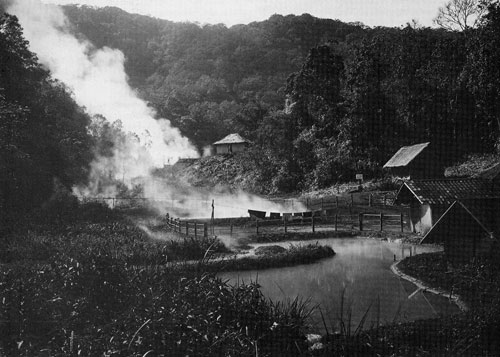 |
#001: Kamodjan Kawah on the western slope of Goentoer is a crater field, a complex of sulphur sources and steam geysers surrounded by primeval jungle. There are radium-containing sources, fumaroles, bubbling gas and mud pools, boiling water and sulphur deposits in a wide range of colours.
“Kawah” means not just “crater”, it is the name for each place with volcanic activity. |
| |
 |
| #002: Sawahs at Tjisoeroepan. In the distance we can see the Tjikoeraj, the ruler over the landscape. The people near the typical bamboo bridge bring the image to life. |
| |
 |
| #003: The collecting of sulphur |
| |
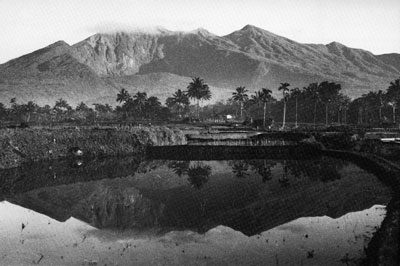 |
| #004: Galoenggoeng volcano to the south-east of Garoet. |
| |
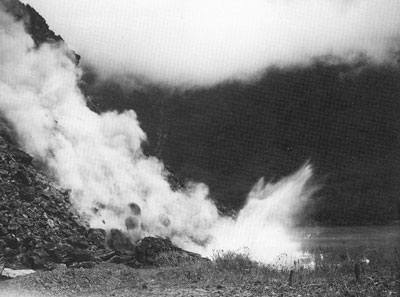 |
| #005: In the eruption of September 1918 glowing lava from the high lava plug flowed hissing into the crater lake of Galoenggoeng. |
| |
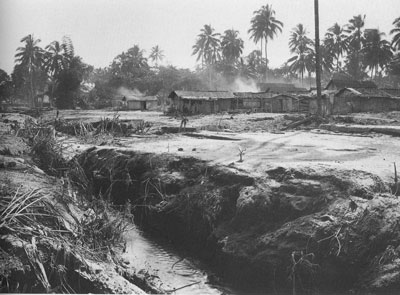 |
| #006: Blitar was destroyed to a great extent by the serious eruption of Keloet in East Java in 1919. The lava – a glowing hot flow of mud – was a good 80 kilometres wide here and there. The content of the crater lake (30 million m3) was splashed high with great force and fell on the surrounding southern hills. There were 5,000 deaths and 1,300 injured to mourn. |
| |
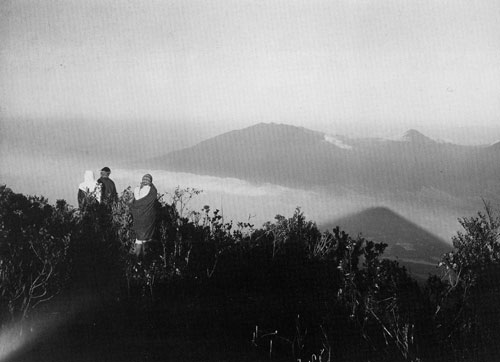 |
| #007: View of Papandajan and the chalk-white gaping of its enormous crater mouth. The photo was taken very early, at sunrise, from the top of Tjikoeraj, where the temperature is particularly low. The three Soendanese guides are covered in the necessary clothing and scarves. To the right, halfway up the picture: the shadow of Tjikoeraj! |
| |
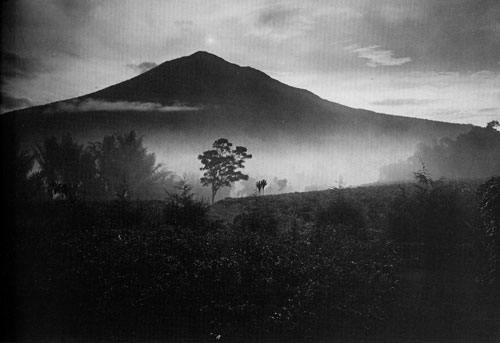 |
| #008: The ornamentally formed Tjikoeraj is 2,800 metres high and of the cone-shaped mountain type. Its crater which is a square kilometre in size has long ago blown out. |
| |
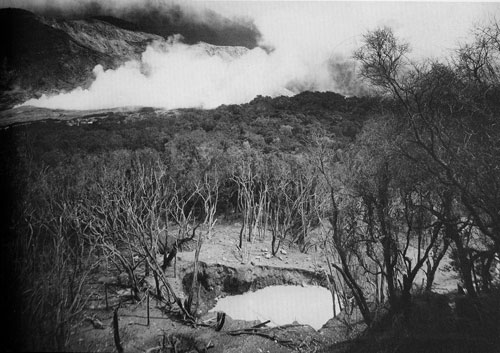 |
| #009: Kawah Baroe came about during the explosion of Papandajan in 1924. With very powerful explosions liquid mud and large boulders were thrown into the air by the steam eruptions. Leaves and bark were ripped from the trees. In the new (= baroe) crater all the vegetation was destroyed by sulphur steam. This steam preserved the wood, so that the trees didn’t die. The wood can neither live nor die. |
| |
 |
| #010: Pangrango and Gedè, twin volcanoes to the south of Buitenzorg. |
| |
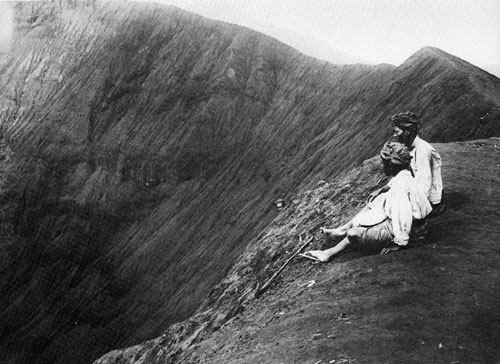 |
| #011: The crater wall of Gedè |
| |
 |
| #012: Sunrise from the top of Pangrango |
| |
 |
| #013: Bromo with the Sand Sea in the clouds. To the left is Batok. |
| |
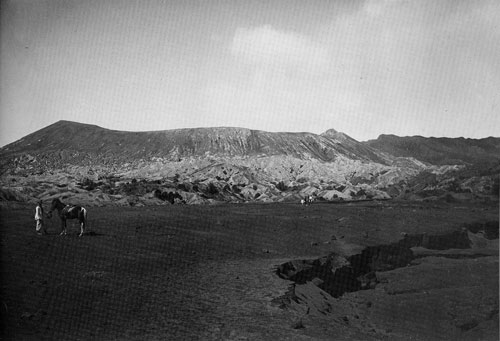 |
| #014: The Sand Sea is a bare, dry area and actually the former bottom of the very large crater of the Tengger volcano. |
| |
 |
| #015: Bromo with its live crater and Batok, so named because of its shape (batok = coconut shell) belong to the extensive, volcanic Tengger-mountains in East Java. Above the clouds the top of Semeroe (3,680 m), Java’s highest mountain and volcano, is visible. |
| |
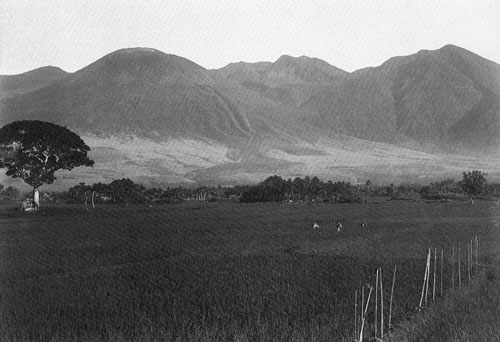 |
| #016: Goentoer, or Thunder Mountain, has twenty craters. Its lava flow poured down below in the shape of a boot from a height of 2,250 metresduring the eruption of 1845. The famous nature researcher Junghuhn (who died in Lembang above Bandoeng after thirty years in the Indies) was a witness to the explosion at Gedè. |
| |
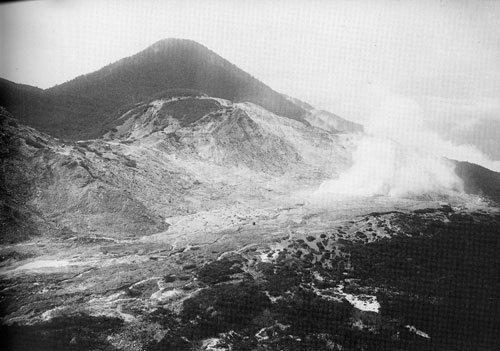 |
#017: Papandajan crater, which lies at an altitude of about 2,600 metres, and which is frequently visited from Garoet and, since 1936, also from Bandoeng.
Papandajan means blacksmith’s workshop. After his visit in 1900, M Buys the first preacher in Bandoeng reports “ …as if we found ourselves in a gigantic blacksmith’s workshop … the hissing and popping, the buzzing and humming like strongly fanned blacksmith fires…”
On the night of 11 August 1772, there was a great explosion with clear sheets of flame and deafening eruptions. In only a few minutes the largest part of the mountain had blown up. In its place stood a large crater. As a result of the flood of ash and stone 2,950 were killed and 40 villages destroyed |
| |
 |
| #018: The hut (= lodge and observation post) of the volcano service at Papandajan. |
| |
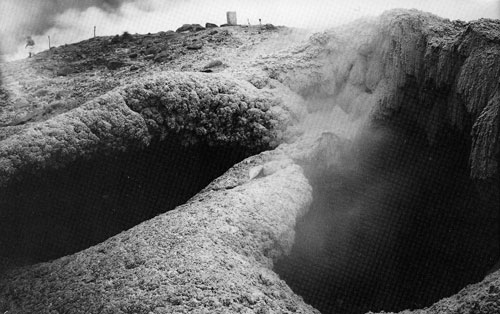 |
| #019: Sulphur gases rise from inside the earth, causing sulphur to be deposited at the edges of the |
| |
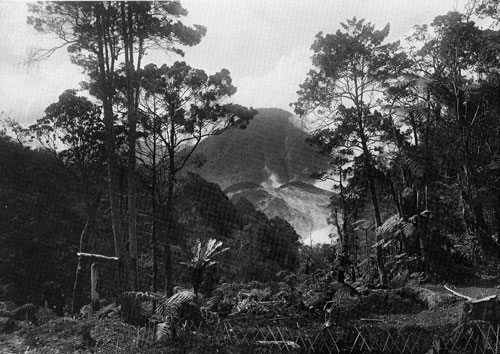 |
| #020: An open spot in the forest on the way to Papandajan crater. |
| |
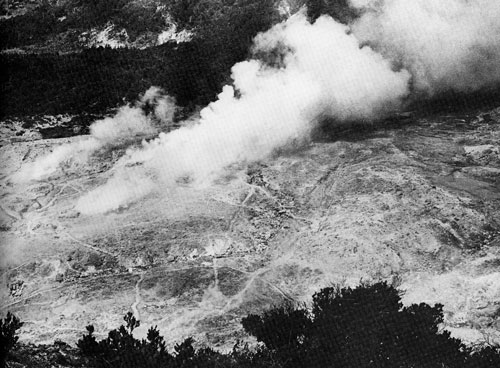 |
| #021:The actual crater of Papandajan: Kawah Mas. Thick white steam clouds rise from it continually. In 1924 a volcano monitoring service was established by Dr Stehn in Bandoeng, the head of volcano research. |
| |
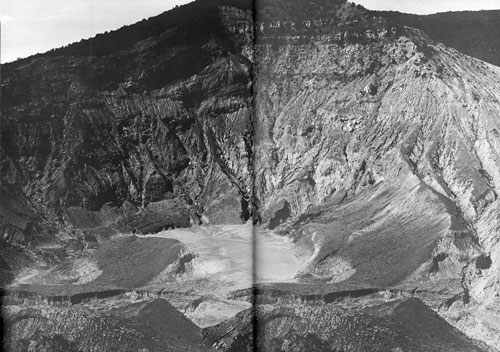 |
| #022: Kawah Ratoe, a crater of Tangkoeban Prahoe volcano – 2,080 metres high – near Bandoeng. |
| |
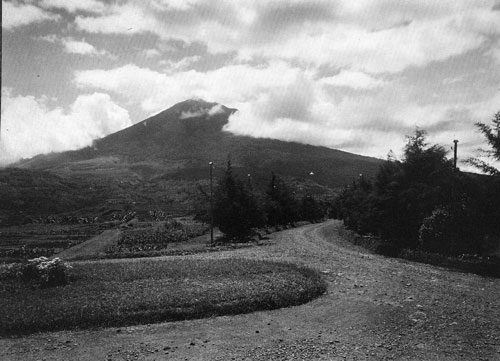 |
| #023: View of the western flank of Tjikoeraj from the hotel at Tjisoeroepan. |
| |
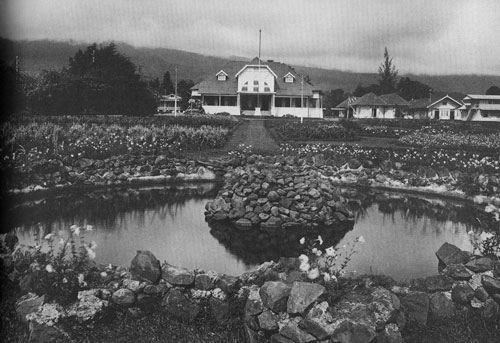 |
| #024: Mountain hotel Tjisoeroepan, before 1920 Hotel “Villa Pauline” owned by Mrs P van Horck, later by the Netherlands Indies Hotel Association. Many tourists began their journey from here to Papandajan crater. |
| |
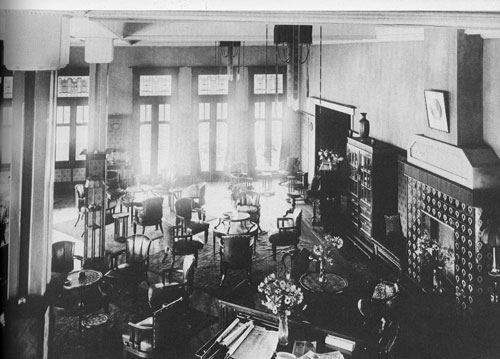 |
| #025: Interior of the hotel at Tjisoeroepan. |
| |
 |
| #026: The “kamar matjan” of the renowned Papandajan Hotel at Garoet, the luxury apartment where important guests were lodged. To the right one of the large rubber trees (ficus) on the grounds. Many a glass is drunk in their shade. |
| |
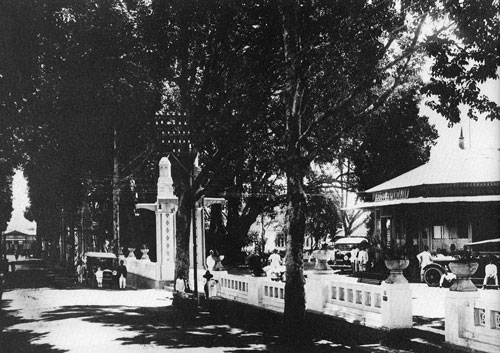 |
#027: Papandajan Hotel.
This hotel, the former van Horck Hotel and Kurhaus Hotel, came into Mr H Hacks's possession in about 1910. Thilly Weissenborn lived in one of the pavilions here for several years. At the end of the street Garoet station can be seen. |
| |
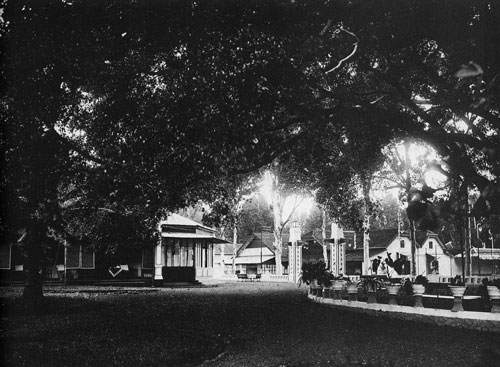 |
| #028: The grounds of the hotel with “the Rotunda”, the lobby for guests |
| |
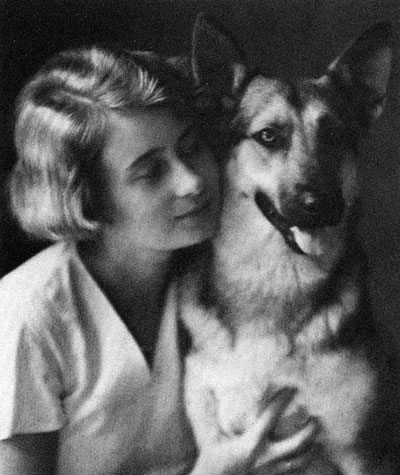 |
| #029: The Hacks had two sons and sandy-haired (twin) daughters. This is Jopie Hacks with her beautiful German shepherd Maja. |
| |
 |
| #030: The Papandajan Hotel’s dining room. |
| |
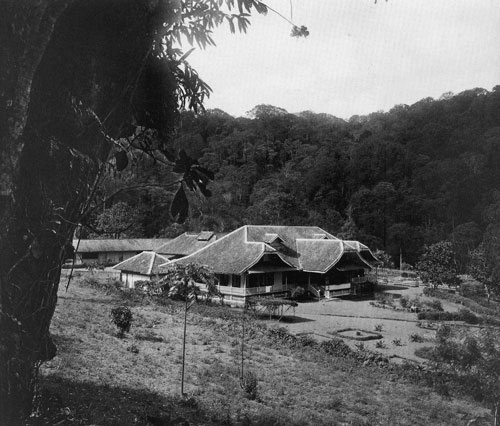 |
| #031: “Radium Hotel Kamodjan” owned by Mr Hacks. He took it over from Mrs van Horck in 1926. This mountain hotel, situated near the Goentoer craters (Kawah Kamodjan) at an altitude of 1,500 metres, bordered on magnificent forests at the back, where one could take most spectacular walks and could admire a treasure of orchids and impressive trees. |
| |
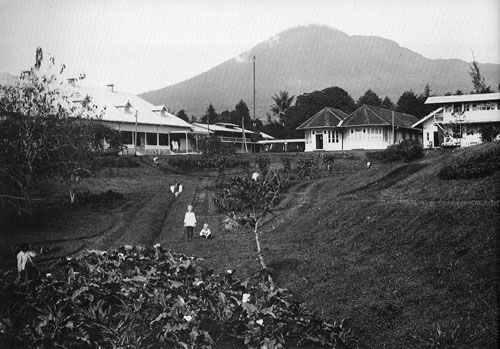 |
| #032: A part of Tjisoeroepan Hotel’s garden with the guest pavilions. In the background is Papandajan. |
| |
 |
| #033: Villa Dolce Hotel at Garoet had its own bakery, a swimming pool and a luxurious garden. The owner was Mr L Ingenhoes. |
| |
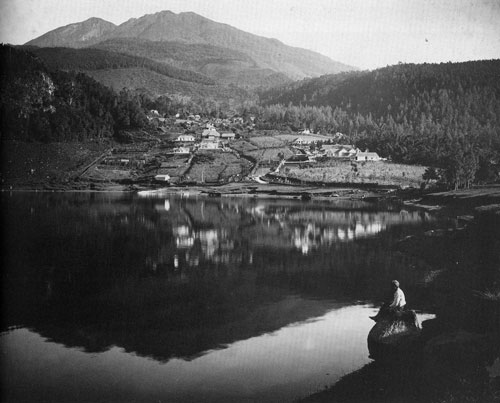 |
| #034: The vacation spot Sarangan at the identically named lake on the southern slope of Mount Lawoe in Central Java. |
| |
 |
| #035: On festive occasions ram fights are held such as this “adoe domba” on the aloen-aloen in Garoet. |
| |
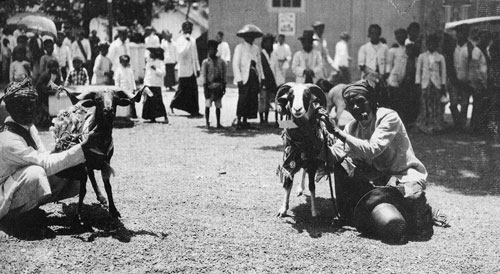 |
| #036: Horned rams. The great crash with which they ram their heads against one another after a run-up doesn’t appear to affect the animals! |
| |
 |
| #037: Soendanese children look on in suspense to see which ram will be the winner. |
| |
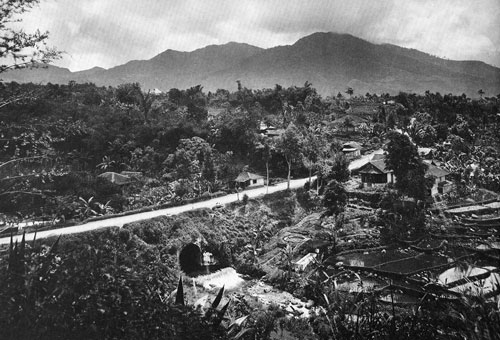 |
| #038: Road through Sindanglaja near the Poentjak-pass with Gedè in the background. |
| |
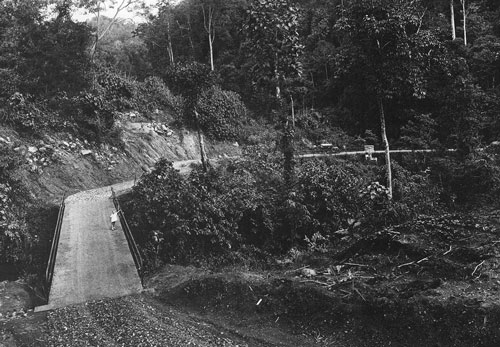 |
| #039: Plantation road from the rubber plantation Boenisari (“Lendra Estate” by the Pirelli company), which we pass on the way to Pameungpeuk. One of the sons of administrator Ament poses on the bridge. |
| |
 |
| #040: The former main road to Tosari in the Tengger mountains in East Java, where a well-known sanatorium was. |
| |
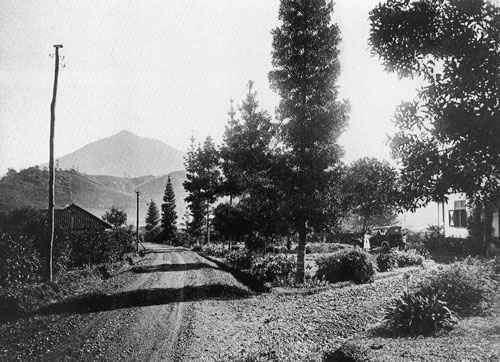 |
| #041: En route from Garoet to the south coast to Pameungpeuk. Mount Tjikoeraj in the distance |
| |
 |
| #042: The railway line to Tasikmalaja in Preanger. |
| |
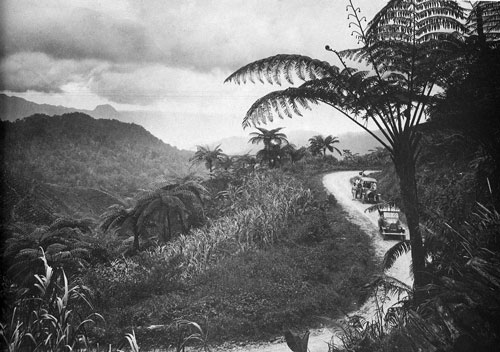 |
| #043: The road from Garoet to Pameungpeuk on the south coast. The road – opened in 1922 – winds its way over eighty kilometres in countless curves downhill through the whimsical jungle of Preanger. |
| |
 |
| #044: An artistically constructed bamboo bridge across the Serajoe river near Wonosobo in Central Java. |
| |
 |
| #045: The road to Diëng plateau at the altitude of Kedjajar village in Central Java. |
| |
 |
| #046: After his installation in 1921 the Governor-General, Fock, takes part in an orientation visit to the Hotel-Sanatorium Ngamplang. Thilly Weissenborn took a group photo there of the G.G. and his wife along with the Resident of Priangen and the Assistant Resident and Regent of Garoet. A regent was the highest-ranking indigenous administration official. |
| |
 |
| #047 & #048 (below): Two shots in the interior of the Governor-General’s palace at Buitenzorg. |
| |
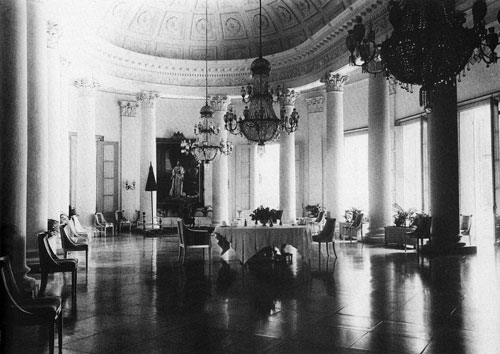 |
| #048: see #47 |
| |
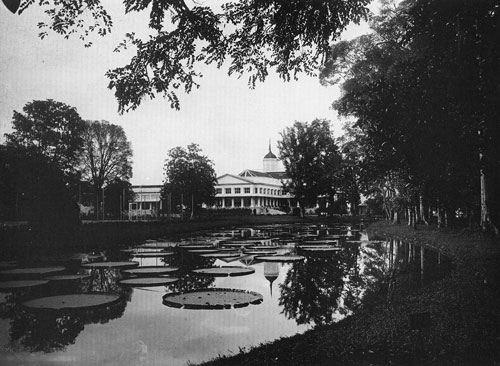 |
| #049: The very extensive botanical garden that was formerly the National Plant Gardens. The garden bordered on the Governor-General’s palace and is till worthwhile viewing today. The pond with the Victoria Regia water plants lies behind the palace. |
| |
 |
| #050: The mountain garden of Tjipodas, of which this pond with swans is a component, also belongs to the National Plant Gardens. The jungle on the slopes of Gedè and Pangrango – behind the lake – are natural monuments. |
| |
 |
| #051: see #050 |
| |
 |
| #052: These portraits were taken by Thilly Weissenborn in the studio or at home. Note the combination of artificial light and daylight. |
| |
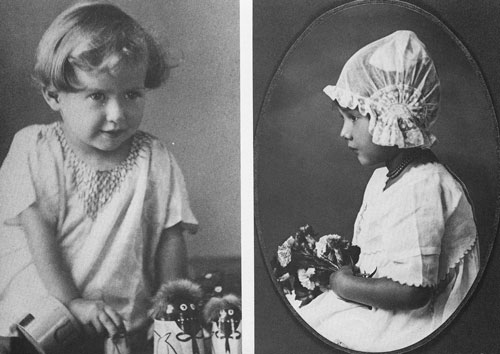 |
| #053: see above |
| |
 |
| #054: Mrs Withaar with her little daughter. For several years until 1932 her husband was the principal of the European Primary School in Garoet. |
| |
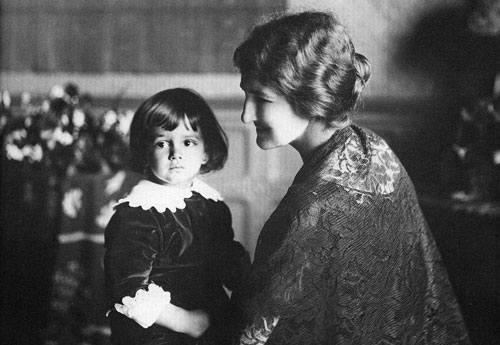 |
| #055: Mrs Kerbosch with one of her sons. Her husband, Dr M Kerbosch, was until 1938 the director of the very important government cinchona enterprise Tjinjiroean in West Java. |
| |
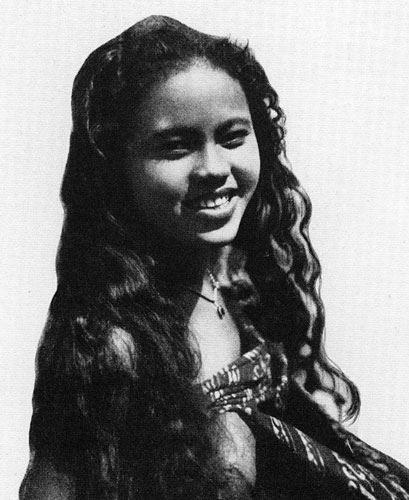 |
| #056: A Soendanese beauty. |
| |
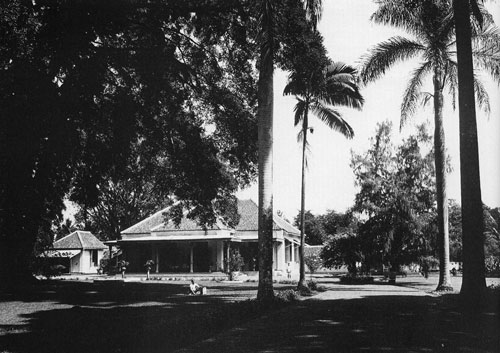 |
| #057: The official residence of the Assistant Resident in Garoet. |
| |
 |
| #058: The Regent of Tasikmalaja in 1920: Raden Adipati Aria Wira noe Ninggrat. |
| |
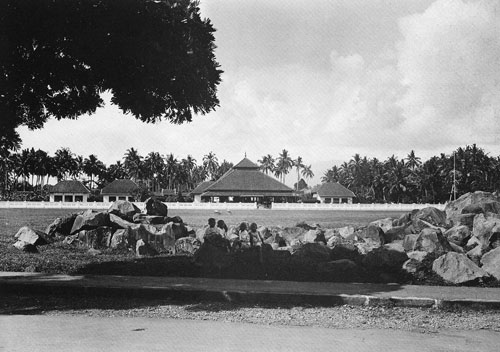 |
| #059: The kaboepaten – official residence of the regent – on the aloen-aloen of Tasikmalaja. |
| |
 |
| #060: Between “Hacks Radium-Hotel” and volcanic Kamodjan-complex lies the so-called “English park” or the “English-plain”, so named because of its marked similarity to an Anglo-Saxon park. It is an extensive grassy surface with groups of trees here and there and a muddy lake: Danau (=lake) Pangkalan. |
| |
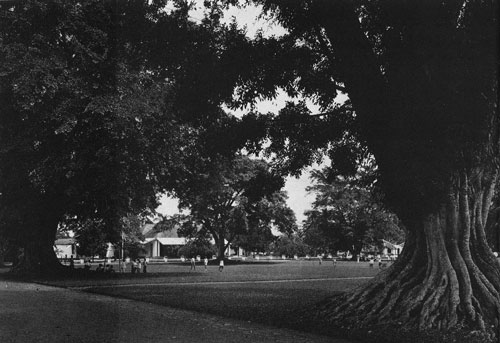 |
| #061: The aloen-aloen of Tjiamis. As always there are banyan trees here as well. The aloen-aloen is the field or public square – usually close to a regent’s residence – where public festivities and official ceremonies took place. |
| |
 |
| #062: The Moluccan Park in Bandoeng |
| |
 |
| #063: The kaboepaten in Garoet with a magnificent banyan tree in the front. |
| |
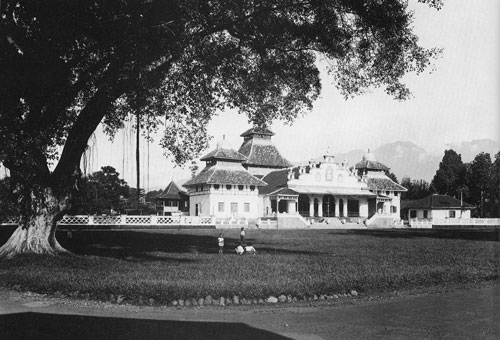 |
| #064:The aloen-aloen of Garoet with – as usual – the masigit (=mosque) on the western side. Incidentally, a ring of grassy land around a wooded peak of a mountain is also called an aloen-aloen |
| |
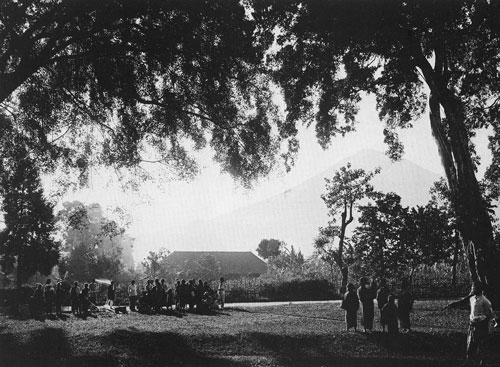 |
| #065: The aloen-aloen of Tjisoeroepan. By the contrasting light effect, the envelopment by the banyan trees and the peace that the human figures radiate, this is one of the most dynamic and also the stillest photos that I encountered. |
| |
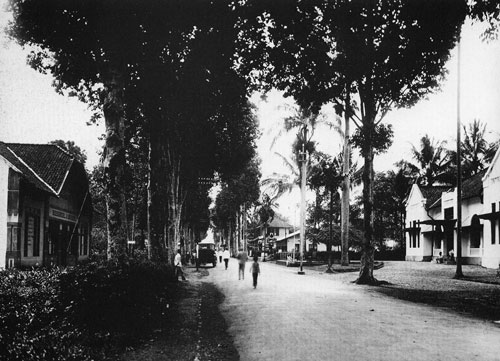 |
| #066: Society Street in Garoet. On the right is the club “Intra Montes”. Further along is the pharmacy, above it the studio “Lux”. On the left the office (bookstore) and reading library of Mr Van Keulen. |
| |
 |
| #067: What remained of the pharmacy and the studio after the destruction. |
| |
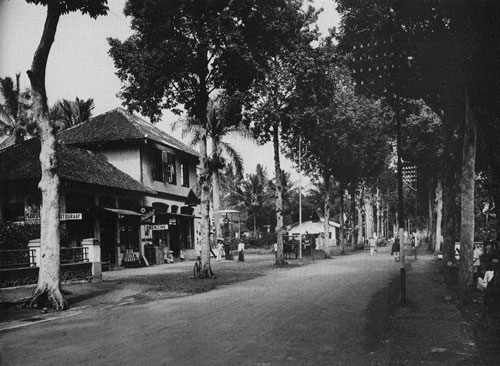 |
| #068: Studio “Lux” above the Garoet Pharmacy of Mr Van der Plas in Society Street where at that time the canari trees still stood. |
| |
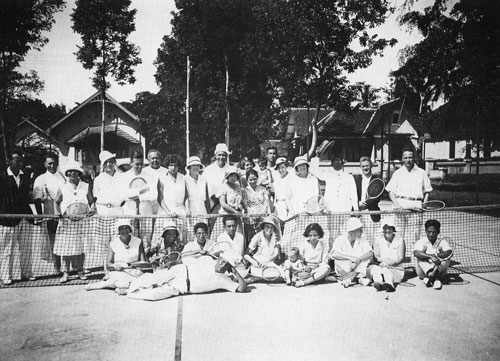 |
#069: The Garoet tennis club on the occasion of the departure of the Assistant Resident Linck – standing in the middle with a tennis hat – in May 1932. Further among others: third from the left Thilly Weissenborn, third from the right the Regent of Garoet. Next to him Mr Holthuis the administrator of the bank “Limbangan”. Lying on the ground Nico Wijnmalen.
Sitting, third from the right – next to my mother with the tennis hat – Engineer Appelman, senior forestry manager and general inspector of forests. Later, from 1957 Engineer Appelman was the director of the animal sanctuary Blijdorp in the Netherlands. In addition to this he was the founder of the Netherlands branch of the World Nature Foundation and private teacher at the Wagening Agricultural College. Seventy years old, he died in 1965 in his place of birth The Hague.
Standing, fifth from the left, Mr Groenendijk, from 1927 till 1936 principal of the Dutch Local School Boedi Prijaji. The Drissen family lived in the house on the right. |
| |
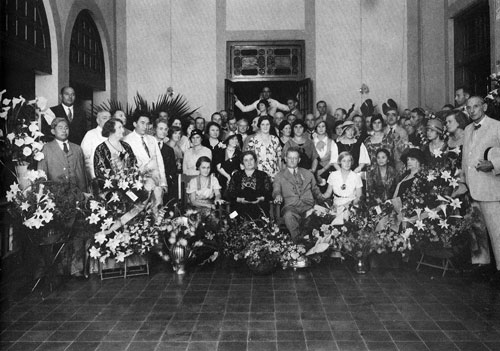 |
| #070: A festive gathering on 5 September 1933 in the Garoet club because of a royal medal that Administrator Van der Veen (from the cinchona enterprise Daradjat) received on his 25th jubilee. Standing in the middle Mrs Biese, since passed away unfortunately, who gave me beautiful photos for this book. In the door opening, GP Dr Rhemrev. On the far left-hand side Nico Wijnmalen and the Regent of Garoet. |
| |
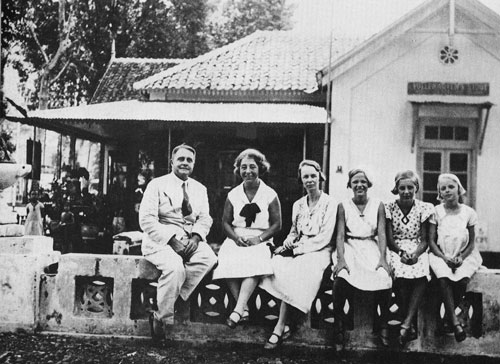 |
| #071: Thilly Weissenborn with the Feuilletau de Bruyn family on the wall of the Papandajan Hotel. Madame was a sister of Dr Mulder, a doctor in Garoet and founder of the sanatorium at Ngamplang. It was he who brought Thilly to Garoet as a photographer. In the background we can see the sales office of Hasan Mansoer. The photo dates from 1934. |
| |
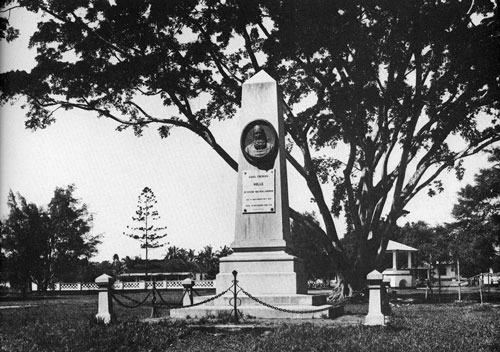 |
| #072: On the Garoet aloen-aloen stood the monument for Karel Frederik Holle (died at Buitenzorg in 1896), the founder of the firm Waspada located near to Garoet. Holle who was called “mitra noe tani”, the friend of the farmer, was one of the pioneers of tea cultivation in Preanger. He was initially in government service for ten years, but his interests extended most to adat and language of the population. He strongly promoted the welfare and development of the Soendanese, together with his friend Raden Hadji Mohamad Moesa in Garoet. The latter was head-panghoeloe (head of mosque personnel and business) in the regency of Limbangan and belonged to a respected Preanger family; one of his sons and grandson the Radens Soeriakartalegawa were – succeeding one another – regents of Garoet after 1915. |
| |
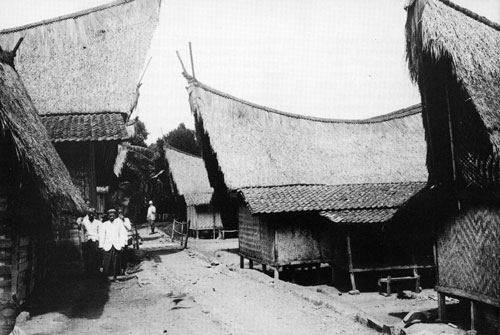 |
| #073: Papandak at Garoet was one of the most remarkable places in Preanger. All the houses, animal stalls and rice barns were of the same type as the Minangkabau in Sumatra. The residences even had a women’s section and were divided symmetrically. Around 1935 Papandak was destroyed by fire. |
| |
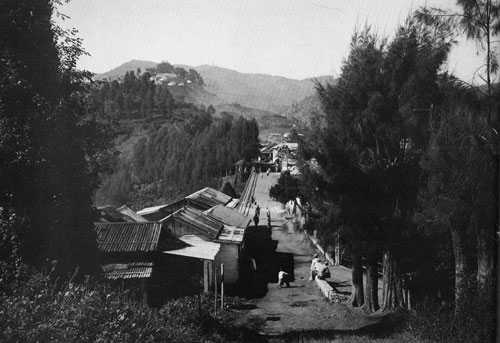 |
| #074: Old shopping street of Tosari in East Java. |
| |
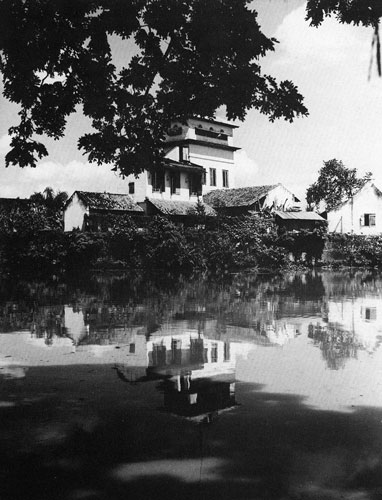 |
| #075: The viewing tower at the entrance to the old harbour of Batavia, until 1883 in use for the needs of shipping. |
| |
 |
| #076: Trees and ferns in the jungle of Kamodjan. |
| |
 |
| #077: The road to Talaga Bodas near Garoet. |
| |
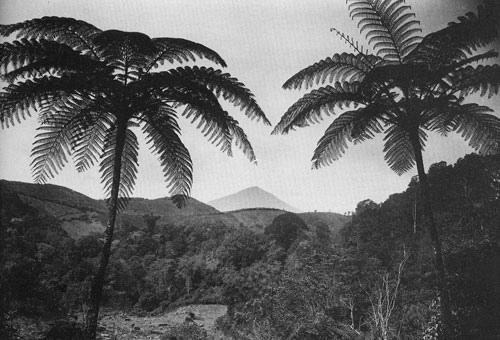 |
| #078: Trees and ferns in the jungle of Kamodjan. |
| |
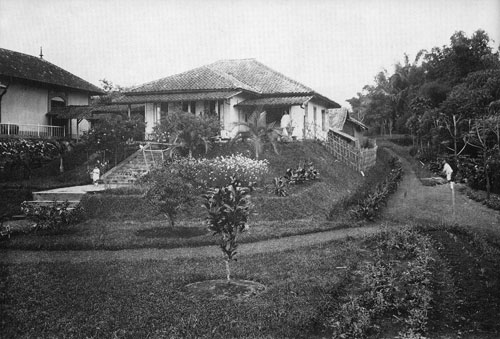 |
| #079: Nurses’ residence at the Ngamplang Sanatorium in 1918. |
| |
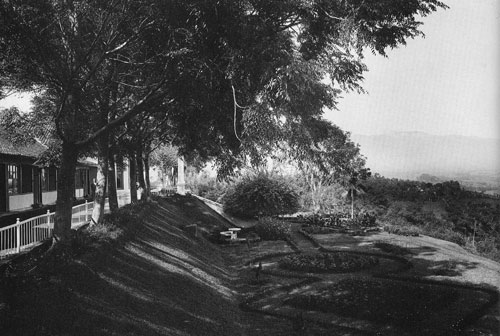 |
| #080: The terrace of several vacation apartments of the Ngamplang hotel, with view over the flower garden. |
| |
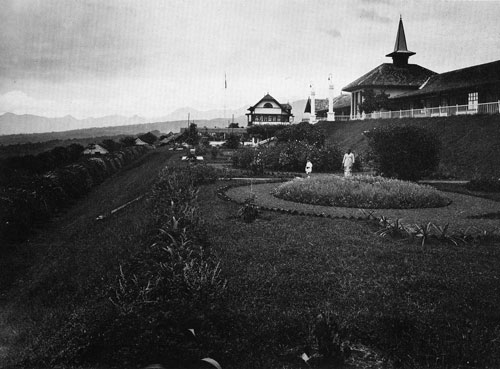 |
| #081: “Ngamplang” near Garoet existed from 1916 to 1946, first as a sanatorium, and afterwards as an important vacation spot and tourist hotel with very extensive accommodation. |
| |
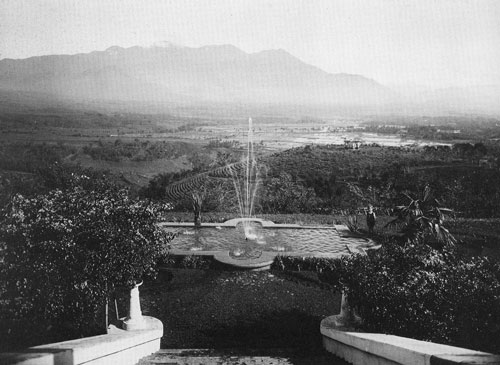 |
| #082: The plains of Garoet from the hotel seen from the northerly direction. In the picture also the Goentoer volcano. |
| |
 |
#083: The complete staff of the Provincial Hospital at Garoet. Under this photo – taken on 1 May 1933 – stands: “Peringetan ka (in memory of) Sister Hulshoff, matron of the Provincial Hospital di (at) Garoet”.
Next to Sister Hulshoff the medical director Pilon (with glasses) and on the right her assistants, who treated me with care when I was there for six weeks with typhus. One place further the government doctor Parjono.
Note the sarongs on those squatting down: each one has a different pattern. |
| |
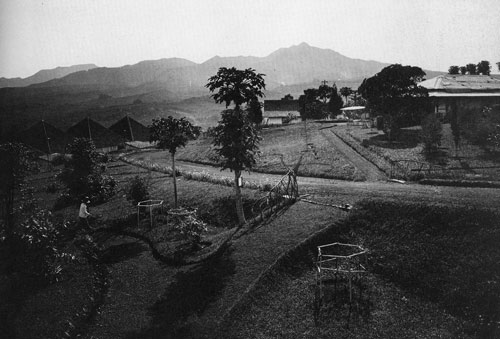 |
| #084: The entranceway to the sanatorium and a portion of the still young garden. In the distance the Kratjak complex can be seen, next to Galoenggoeng. |
| |
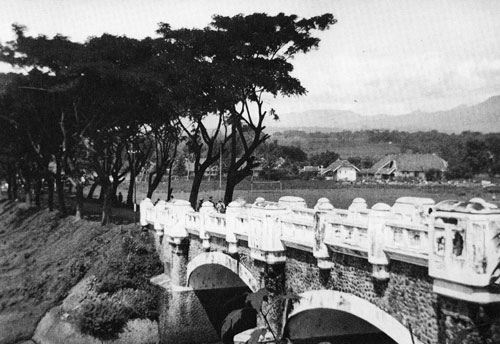 |
| #085: In 1922, Thilly Weissenborn took the photo below at the opening of the Garoet hospital. The recently planted trees along the road are barely visible. On the photo to the left, which I took in 1934 with my Zeiss-Ikon box camera they have grown to graceful rainforest trees. |
| |
 |
| #086: see #085 |
| |
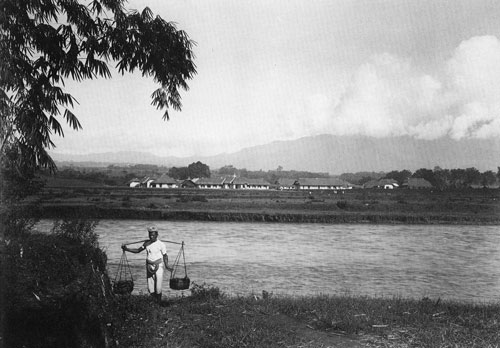 |
| #087: Another view of the hospital, this time across the Tjimanoek, with Goentoer in the clouds. The man in the foreground has gathered stones from the river and is transporting them in sturdy woven bamboo baskets. |
| |
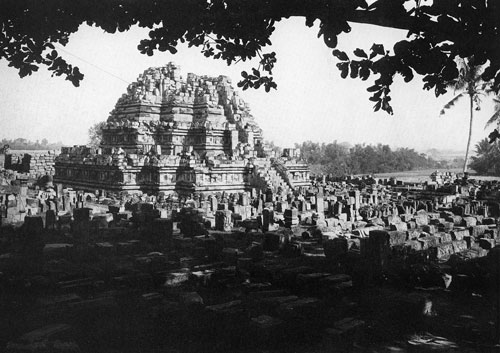 |
| #088: A Prambanan temple which belongs to the most beautiful and most famous group of Hindu structures in Central Java. These lie to the south of the volcano Merapi. |
| |
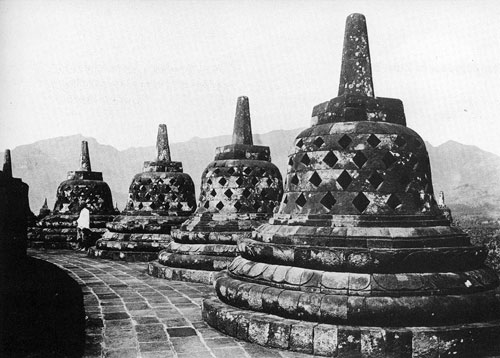 |
| #089: Bell-shaped cupolas – stupa – on one of the galleries of Boroboedoer. In such a stupa a statue can be found. |
| |
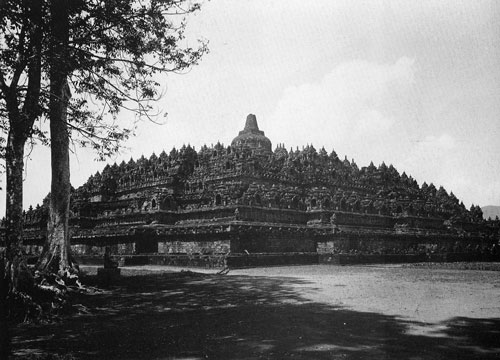 |
| #090: Boroboedoer in Central Java: the largest Buddhist construction in the world. |
| |
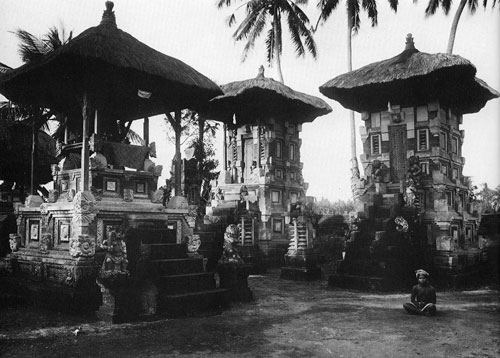 |
| #091: Temple structure in South Bali. |
| |
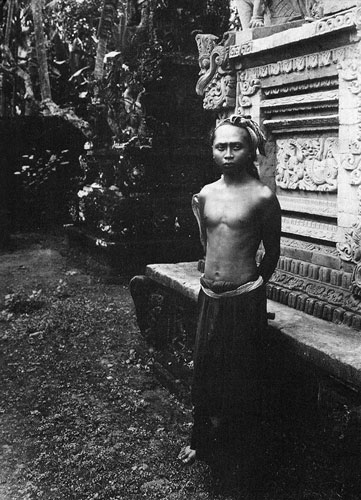 |
| #092: (no caption) |
| |
 |
| #093: An offering house of the Poera (= temple) Besakih, the main temple of Bali, on the slopes of the holy Goenoeng Agoeng in the vicinity of Karangasem. This temple was spared during the great eruption of 1971. |
| |
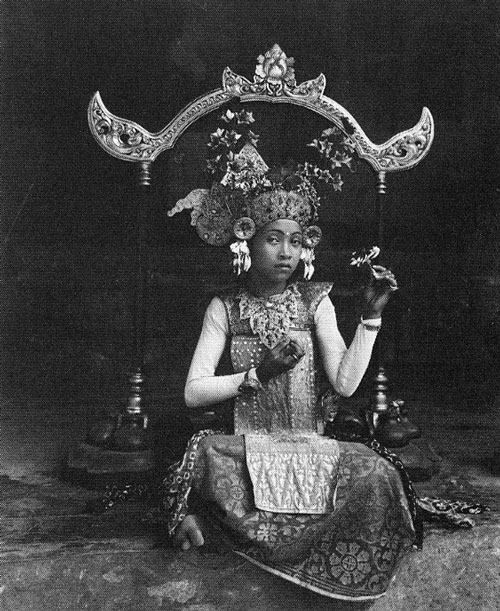 |
| #094: Balinese dancing girl. She wears rich ornaments and a beautiful cloth around the torso. The Balinese weavings are decorated with gold-thread. |
| |
 |
| #095: Sangsit temple near Boelèlèng, North Bali, which excels through rich ornamentation and paintings. |
| |
 |
| #096: Temple gates in Soekawati, South Bali. In the foreground two shrines. |
| |
 |
| #097: A pedanda (Hindu priest) with the implements that are used in religious ceremonial activities. Gamelan of Gianjar |
| |
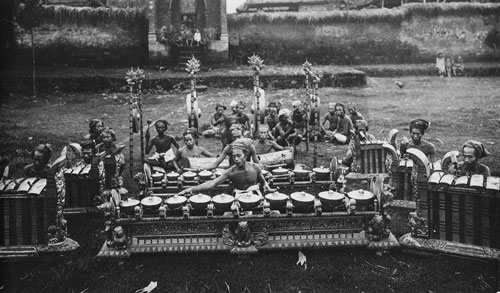 |
| #098: Gamelan of Gianjar |
| |
 |
| #099: A Hindu temple in the holy forest of Blakioeh. |
| |
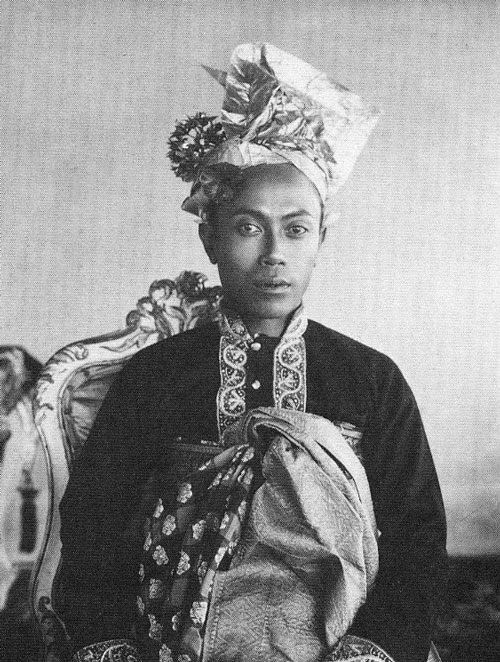 |
| #100: The Goesti Bagoes Djilantik, Vice Regent of Karangasem. |
| |
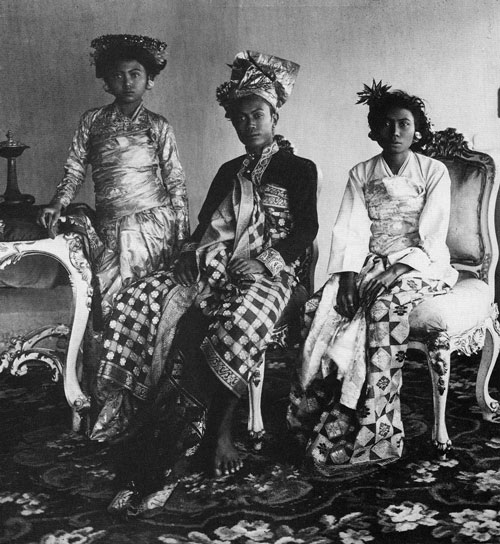 |
| #101: The Goesti Bagoes with wife and daughter |
| |
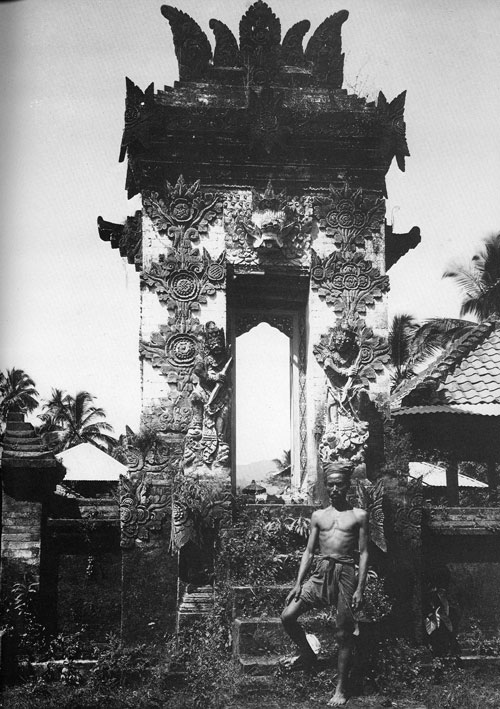 |
| #102: Temple gate of the Poera Soebak in North Bali. |
| |
 |
| #103: Balinese women on the way to a sacrificial ceremony. |
| |
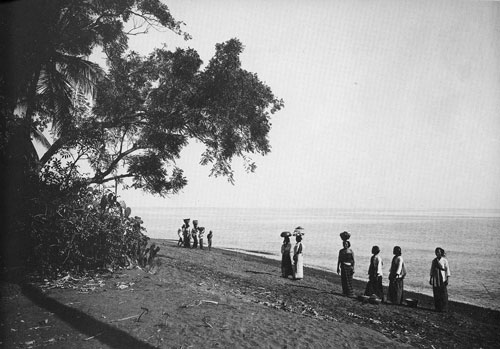 |
| #104: Balinese women on the way to Besakih. |
| |
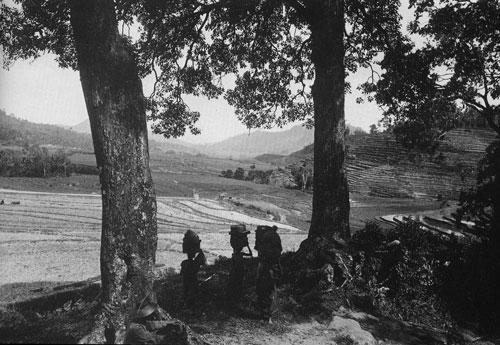 |
| #105: Balinese women on the way to Besakih. |
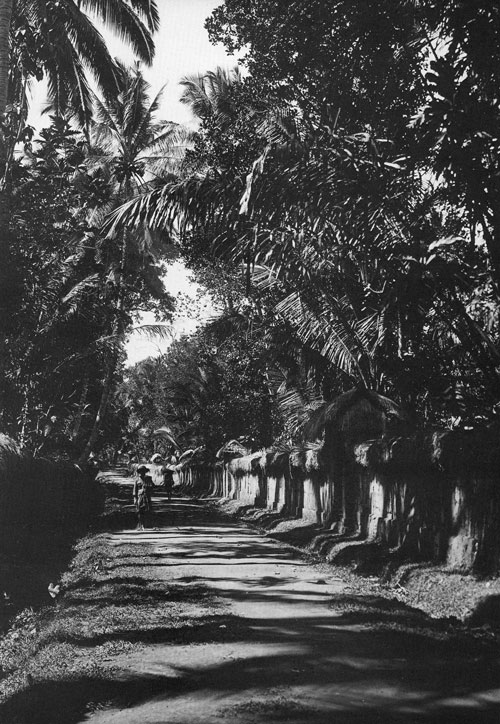 |
| |
| #106: Laneway with clay walls in Bali. |
| |
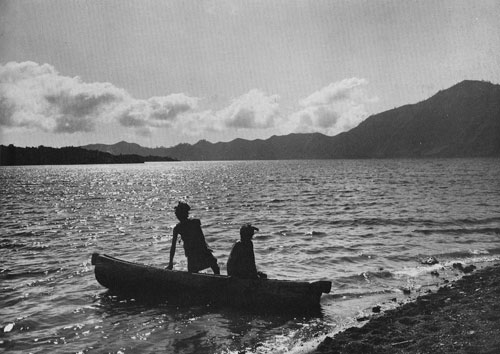 |
| #107: Lake Batoer. |
| |
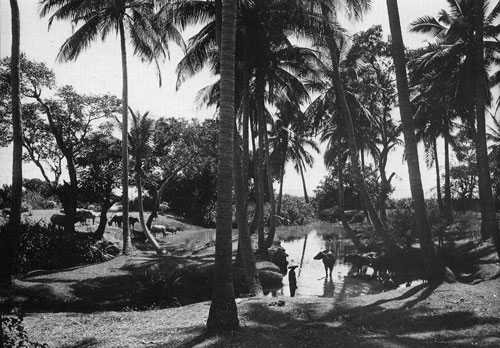 |
| #108: Buffaloes with their keepers, at a picturesque spot on the north coast. |
| |
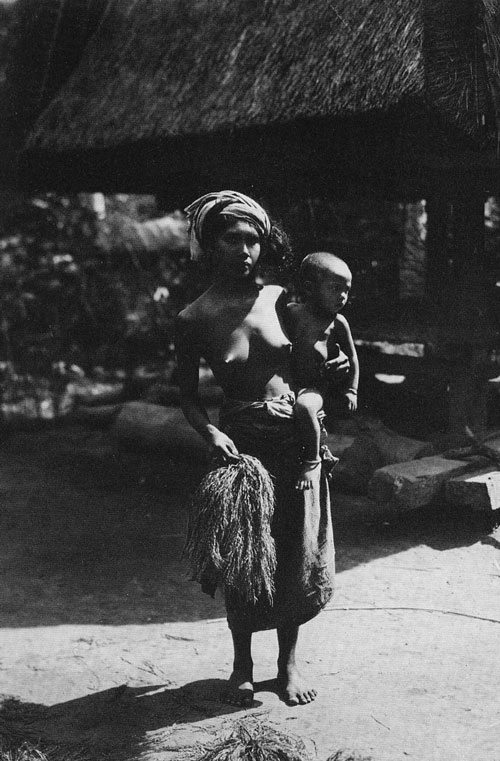 |
| #109: Young mother busy at the rice barn. |
| |
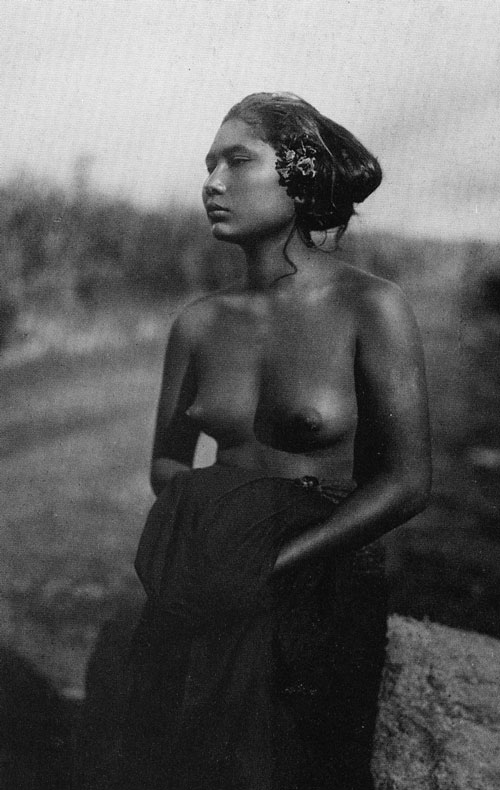 |
| #110: A Balinese woman. |
| |
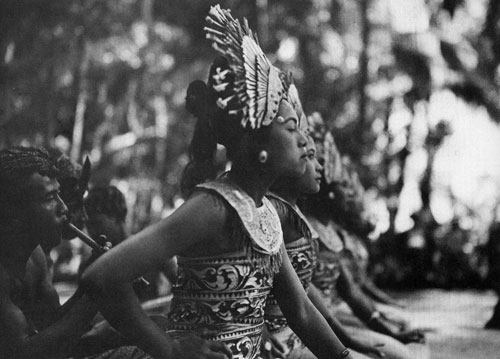 |
| #111: Balinese dancers. |
| |
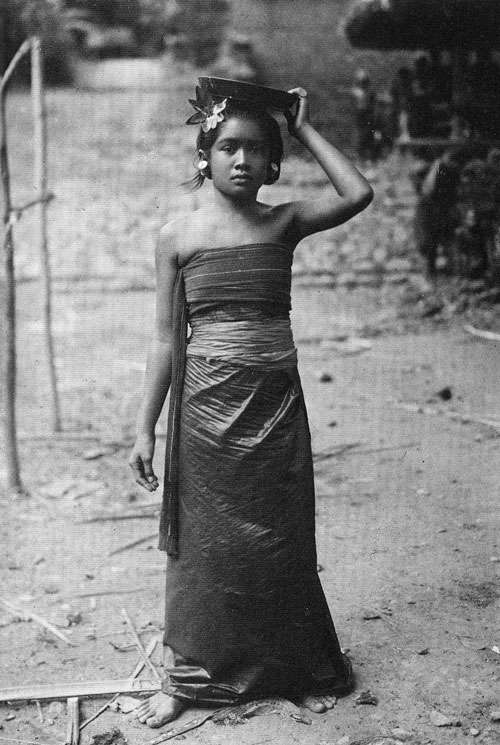 |
| #112: (no caption) |
| |
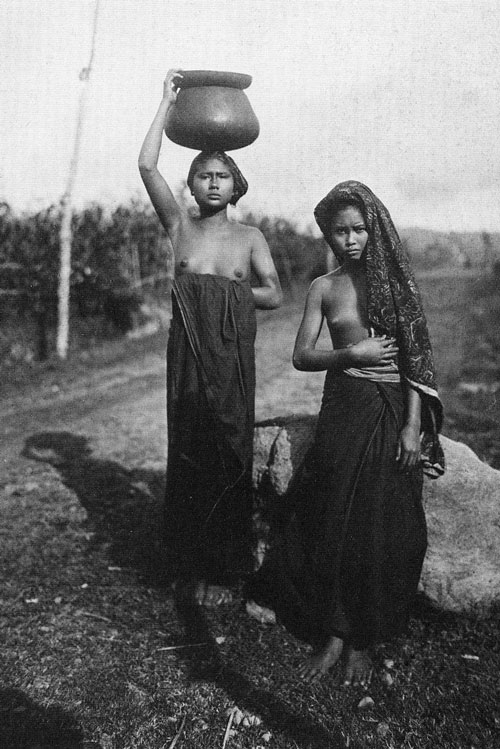 |
| #113: (no caption) |
| |
 |
| #114: The wise Balinese. |
| |
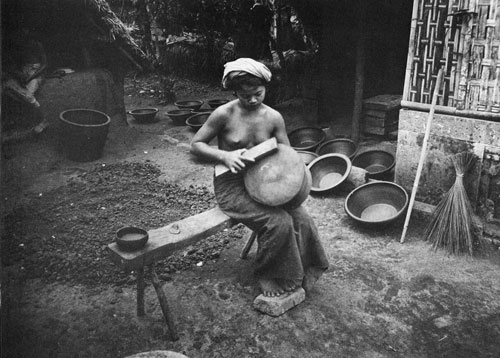 |
| #115: Manual work – there is still no talk of mass production, machines and computers. |
| |
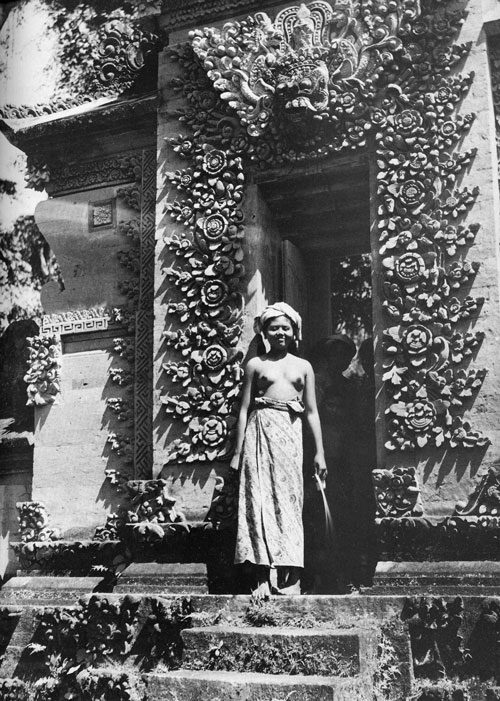 |
| #116: Beautiful ornamentation of a temple gate |
| |
 |
| #117: Pameungpeuk Bay on the south coast of West Java with the former strand hotel and the pier, where in its time KPM ships had to moor, but which proved not be suitable for this purpose. Here it is called Tjilaoeteuren – “where the water of the sea stops”. |
| |
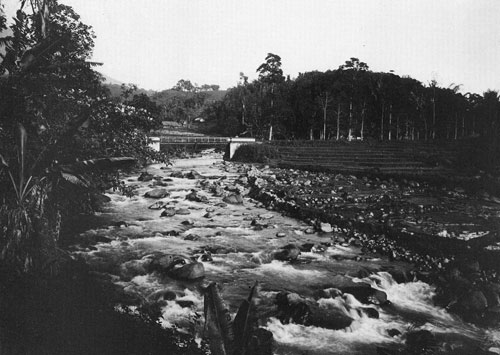 |
| #118: En route from Garoet to Tasikmalaja. |
| |
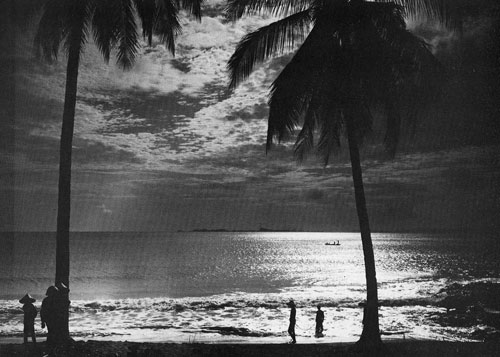 |
| #119: Sunset in the most north western point of Java on the beach at Merak. |
| |
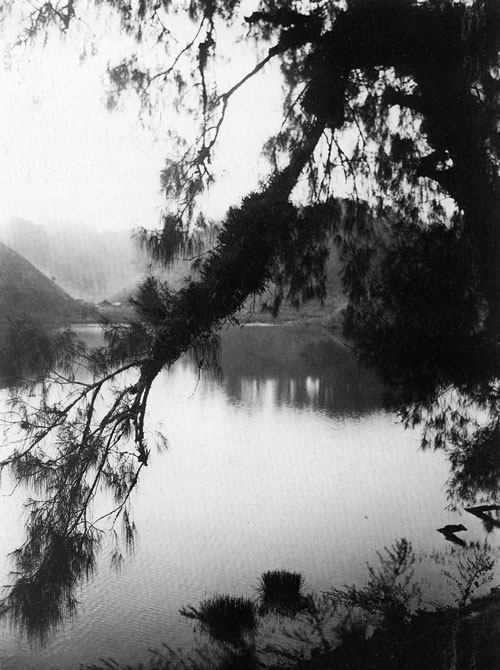 |
| #120: A photo with lots of atmosphere of Ranoe (= lake) Pani near Tosari |
| |
 |
| #121: Talaga Bodas, crater lake on Galoenggoeng. It is a lake with double salts of sulphate, light greenish white. Because of the sulphuretted hydrogen that continually bubbles up no life is possible in it. |
| |
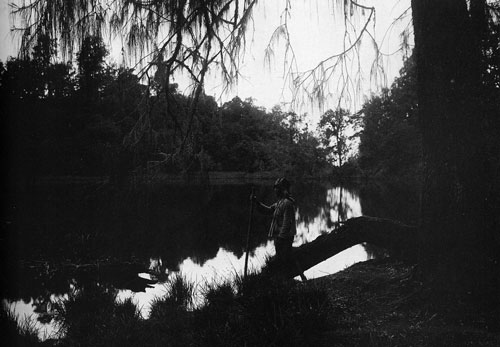 |
| #122: Ranoe Regoelo near Tosari in East Java. The figure is most probably a guide. |
| |
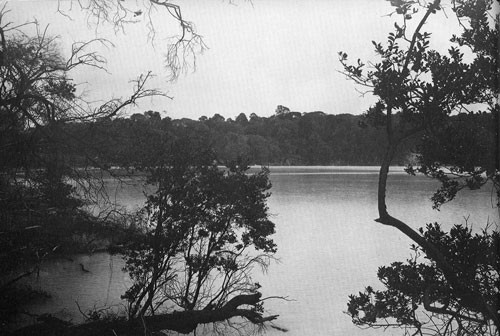 |
| #123: The crater lake Talaga Bodas near Garoet. |
| |
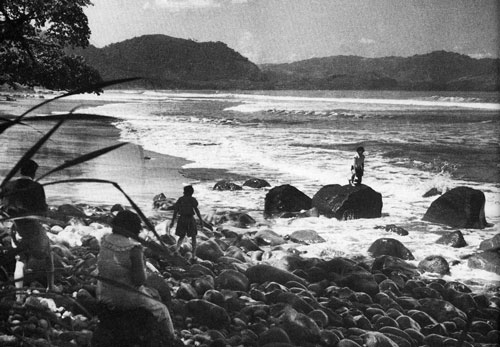 |
| #124: Wine Merchants Bay. |
| |
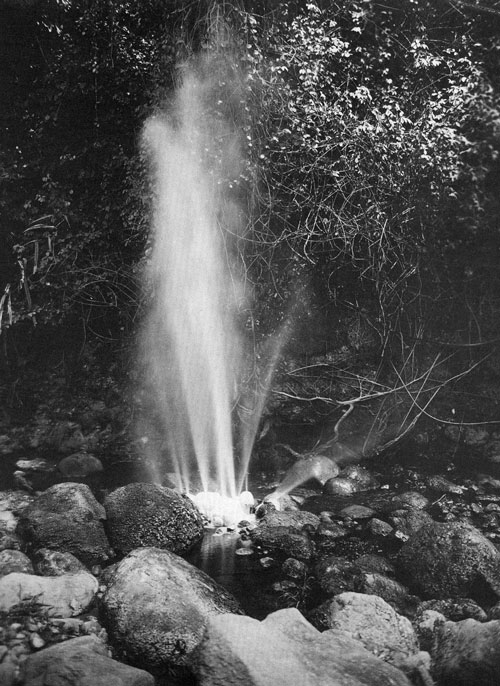 |
| #125: Spouting hot springs near Tjisolak at Wine Merchants Bay. Very remarkable geysers at the bottom of the river: there is cold and warm water at the same time. |
| |
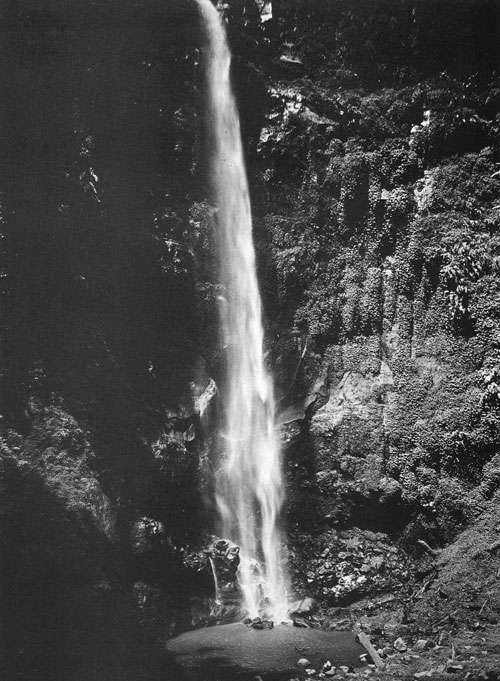 |
| #126: The Ramboet Mojo waterfall near Nongkodjadjar to the southwest of Tosari. |
| |
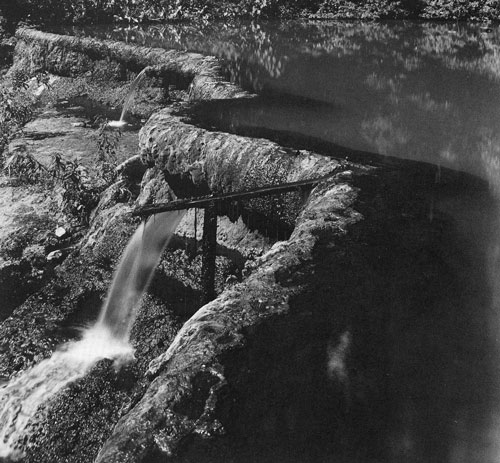 |
| #127: Djeding on the Idjen highlands in East Java. This is a strong chalk-bearing warm water basin and drainage reservoir of the crater lake of the Kawah Idjen, the largest crater lake in Java. |
| |
 |
| #128: A view to the southwest from the bridge to the Garoet Hospital. In the distance Tjikoeraj; in front of us we see the Tjimanoek river, which has its source in Papandajan. |
| |
 |
| #129: Sitoe Tjangkoewang (tjangkoewang is a type of reed) or the lake of Lèlès on the high plain of Garoet. In the lake is the islet Salem. |
| |
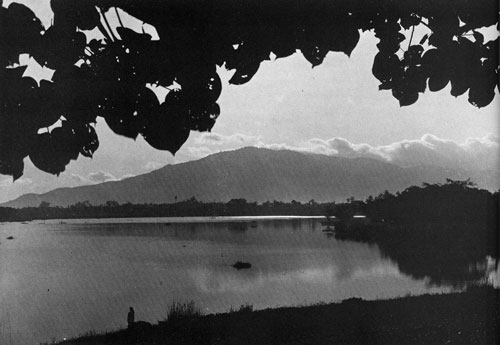 |
| #130: Sunrise at Bagendit lake. |
| |
 |
| #131: Sunset at Pameungpeuk Bay. |
| |
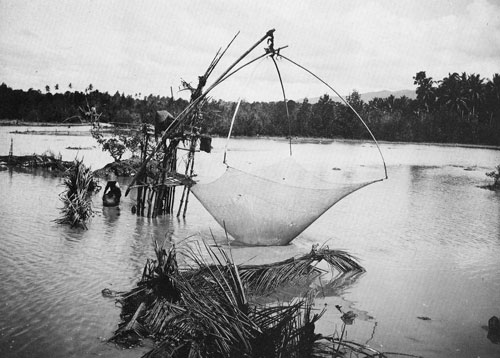 |
| #132: Fish ponds at Laboean on the west coast of Java. |
| |
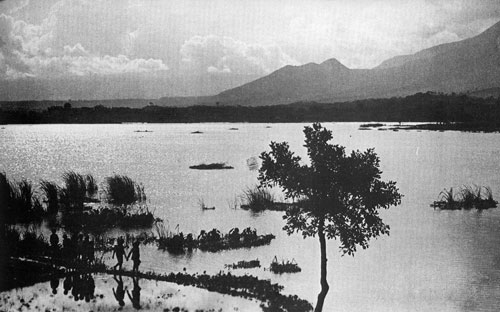 |
| #133: Twilight in Java is short but can be breathtakingly beautiful, such as here at Bagendit lake. |
| |
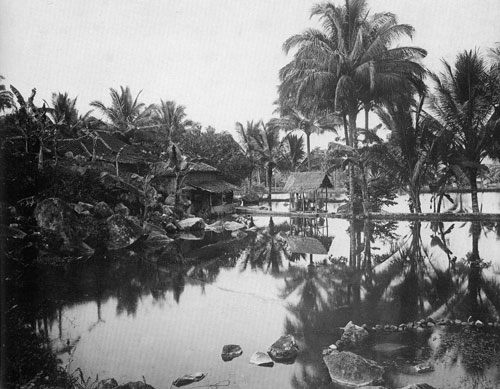 |
| #134: One of the many fish ponds of Tjipanas at the foot of Goentoer. They raise primarily goldfish, carp and goeramè with its long feelers as breast fins. In the saoeng – that is what the structures with a capping are called – in this photo they are busy with paddy-stamping. The stone blocks are of volcanic origin. |
| |
 |
| #135: The vacation spot Sarangan and the crater lake against the slope of Lawoe in Central Java. |
| |
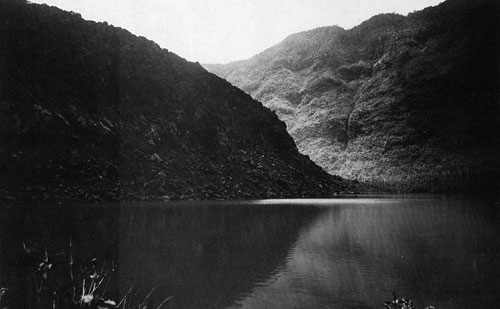 |
#136: Mountain lake of the 2,200 metre high volcano Galoenggoeng to the south east of Garoet.
In 1823 there was an eruption of mud and steam, which brought about great destruction. Four thousand people lost their lives, and one hundred and fourteen villages were damaged.
The second great explosion took place in 1894. On that occasion there was no loss of human life to mourn.
The 150 metre tall lava plug to the left on this photo occurred after the eruption of September 1918. The recent explosions from 1982 until mid-June, thirteen in total, went hand in hand with very troublesome ash rain that extended as far as Jakarta. |
| |
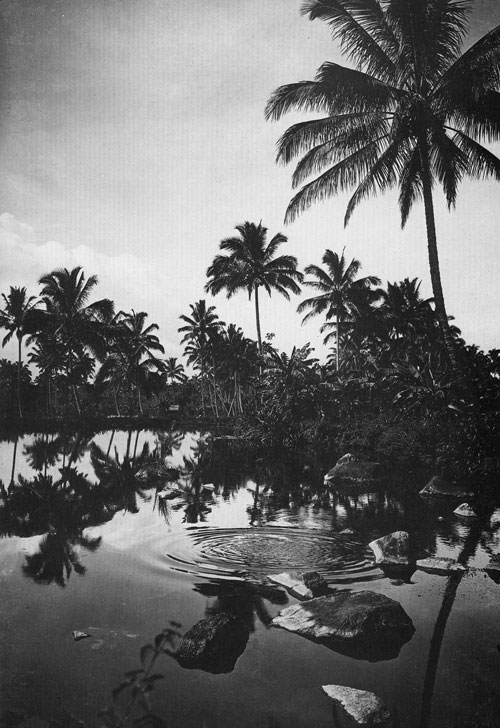 |
| #137: Fish ponds of Tjipanas. In this area countless coconut and banana trees also grow. |
| |
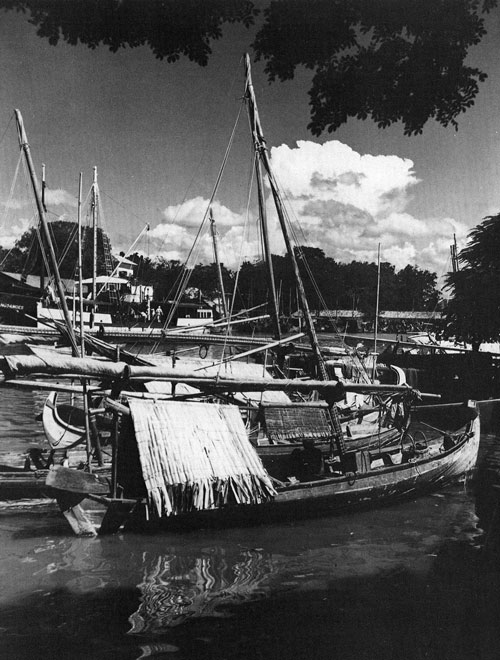 |
| #138: Pasar Ikan at Batavia, a portion of the old harbour, principally for the fish trade. On the left “the Lookout” can still be seen. |
| |
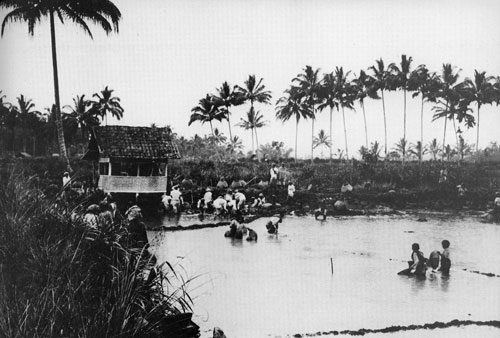 |
| #139: Fish catching at a fish pond of Tjipanas. |
| |
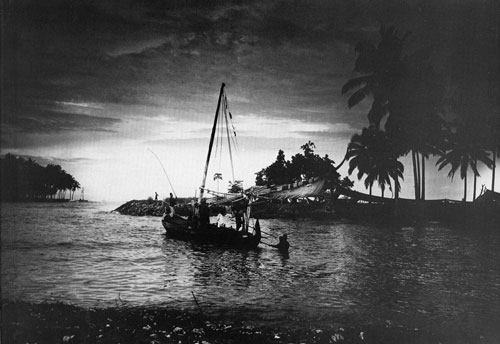 |
| #140: Fishing boat at Laboean on the west coast of Java. |
| |
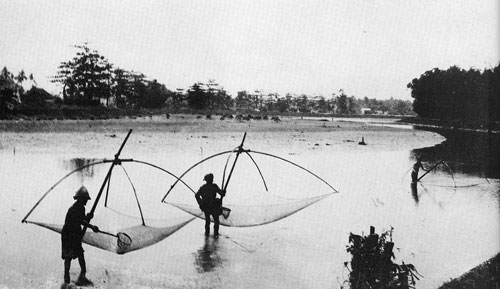 |
| #141: Fish catching in Tjimanoek river |
| |
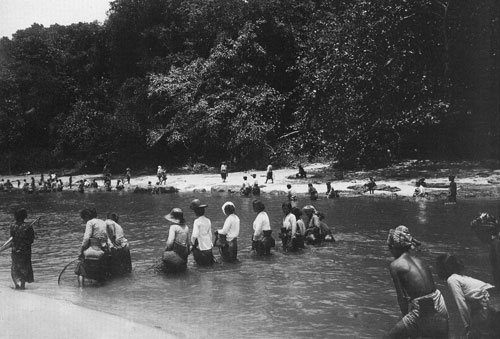 |
| #142: Fish catching at Pameungpeuk |
| |
 |
#143: Old Chinese residential buildings and warehouses
in the vicinity of Pasar Ikan |
| |
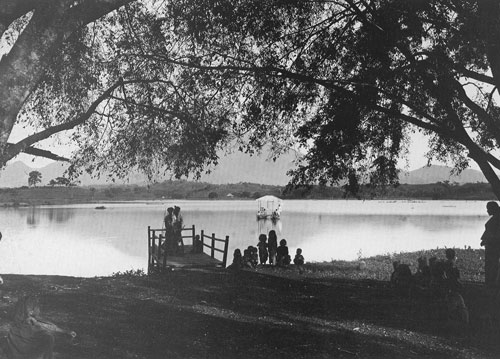 |
| #144: Attractions of Sitoe (= lake) Bagendit in the Garoet plain were the joy trips with floating houses and the dreamy music that is made with angkloengs for tourists. |
| |
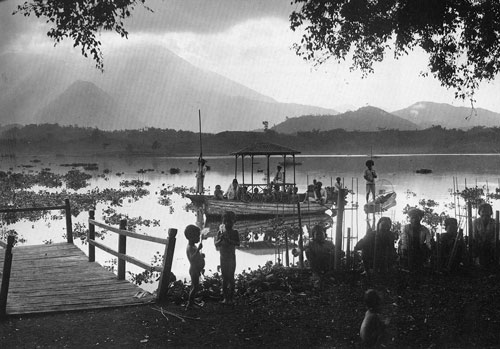 |
| #145: Angkloeng players in Preanger. In a bamboo frame vertical bamboo tubes are placed (each one an octave lower than the previous one), which can move to and fro in a horizontal tube. This forms the basis of the frame which is shaken. The angkloeng, an instrument that is played in West Java (primarily in Preanger) produces soft clapping tones, sing-song, dreamy, mysterious. One or two Soendanese children dance and sing. Tuned differently, depending on their size, the angkloengs accompany song and dance. The pitch is dependent on the shape, length and thickness of the tubes. |
| |
 |
| #146: see above #145 |
| |
 |
| #147: The girl from Preanger whom her little brother is clutching onto with all his might. |
| |
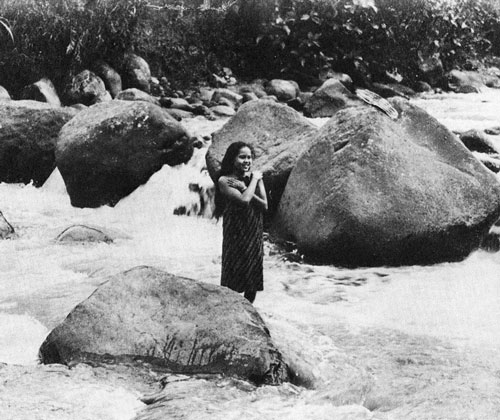 |
| #148: Creation of nature. |
| |
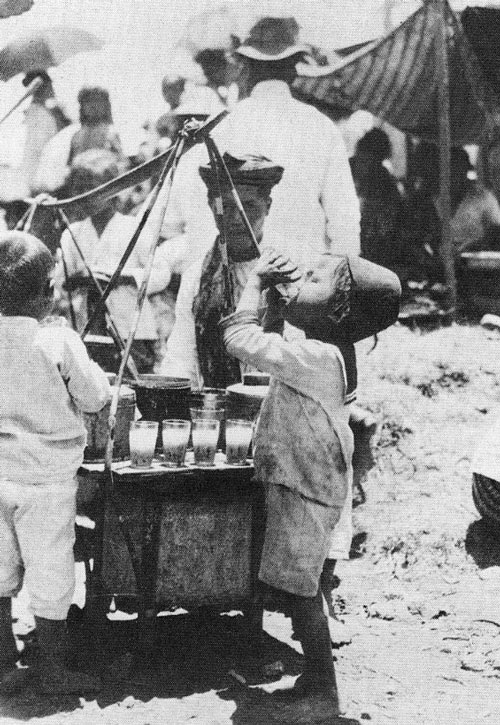 |
| #149: It is a holiday and this little boy is treating himself at the toekang tjendol, the tjendol seller, with a glass of this delicacy. |
| |
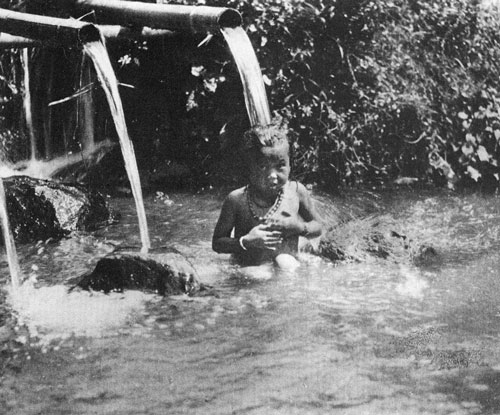 |
| #150: A Soendanese infant enjoys himself while bathing under a pantjoeran, a bamboo tube that serves to transport water. |
| |
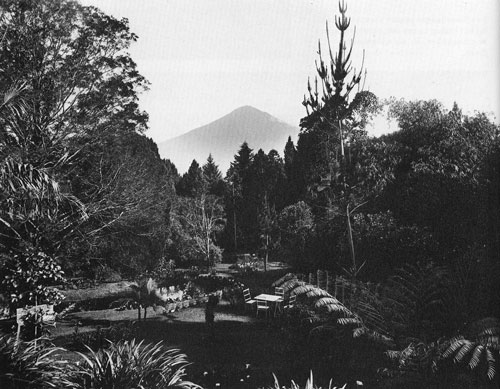 |
| #151: The garden of the “besaren” (administrator’s residence) at the cinchona enterprise in Garoet, where Thilly Weissenborn paid many a visit to her friends the Van der Veens. |
| |
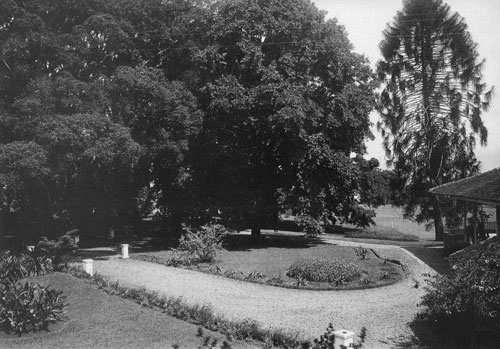 |
#152: The entrance way in the luxuriant garden of the Lodji, the house of the administrator of the firm Djatinangor where, among others, Oscar Weissenborn lived in 1930. The large banyan trees must have been a good eighty years old then.
The owner of Djatinangor – the firm was obtained through a long lease – was also the first administrator: W A Baron Baud. In 1879 he was buried at a short distance from his house. This firm, a piece of my youth, lay between Bandoeng and Soemedang. |
| |
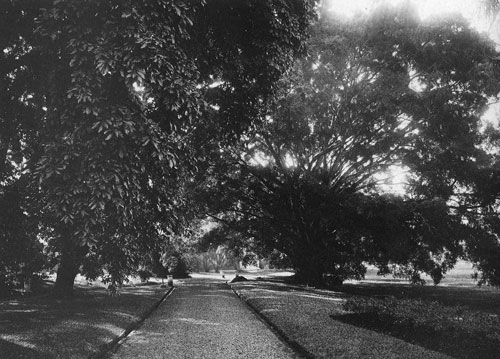 |
| #153: see #152 above |
| |
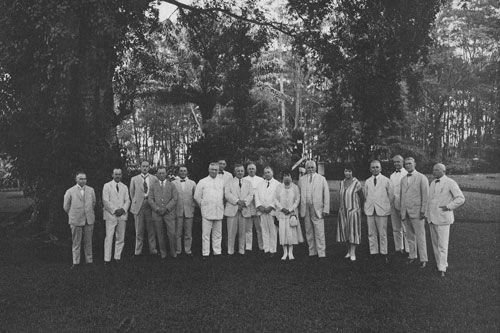 |
| #154: The administrators – only a few names are known to me – of the cultural enterprises of the Baud Company in 1926 on the visit of Baron and Baroness von Klitzing-Baud at the enterprise Tjioemboeleuit above Bandoeng, my place of birth. |
| |
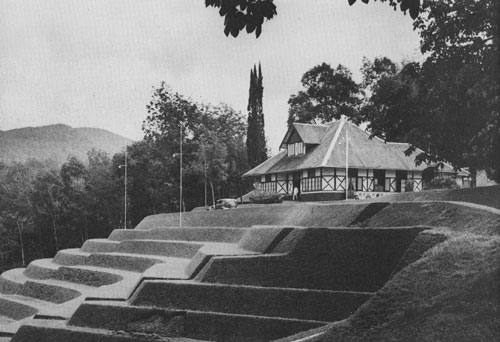 |
| #155: On the basis of their friendship, Thilly Weissenborn also stayed many times at the house of administrator Ament and his wife at Boenisari, the rubber firm between Garoet and Pameungpeuk. |
| |
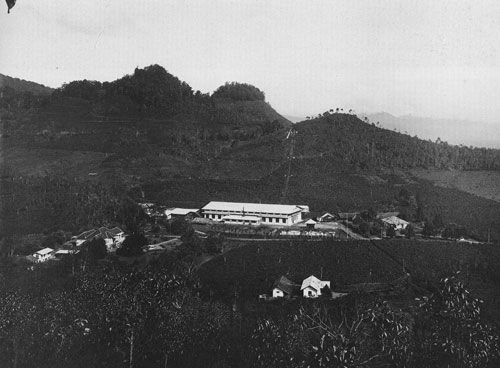 |
| #156: The tea factory and employees’ houses at the Pamegatan enterpriser of the Baud Company. In the house on the right the Drissen family lived. |
| |
 |
#157: Pluckers – a joy for the eye but (especially for the photo) dressed too well – of the Malabar enterprise, on the southern slope of the similarly-named volcano at Bandoeng.
The enterprise was founded at the end of 1921 and developed by the famous planter K Bosscha. He was also the first administrator of Malabar. Due to his many services he was made an honorary citizen of Bandoeng in 1920. He died at the end of 1928. His monumental grave lay on the spot where he had begun to work the jungle, near the administrator’s house.
Bosscha was well respected; he was rich but generous. Amassing his fortune in Preanger, he viewed it as a valuable possession that should be returned for the good of the land. |
| |
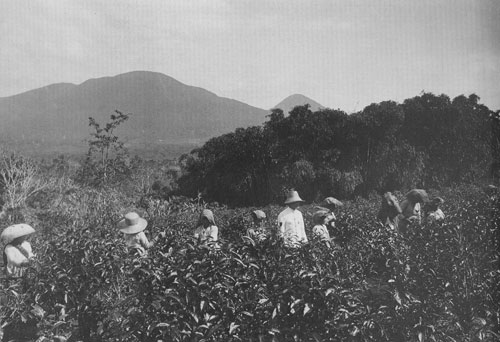 |
| #158: Tea pluckers at work under the supervision of the mandor (supervisor). |
| |
 |
| #159: Soendanese tea plucker |
| |
 |
| #160: Tea plucking: the top three or four leaves are plucked from the tea bush. The pluckers bring the plucked leaves collected in cloths to the factory, where the leaves are spread out on long drying racks and stay there for a day. This “withering” process makes the leaves more supple. Afterwards they are ground (“rolled”) in machines between two copper discs. This process takes only a short while. Subsequently the tea is dried in drying ovens at a high temperature – for an equally short time, after which they end up on angled vibrating sieves with openings of various sizes, through which the tea is sifted. |
| |
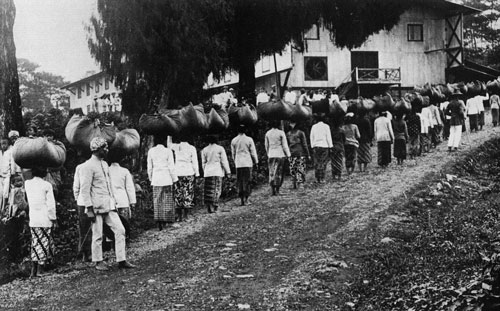 |
| #161: no caption |
| |
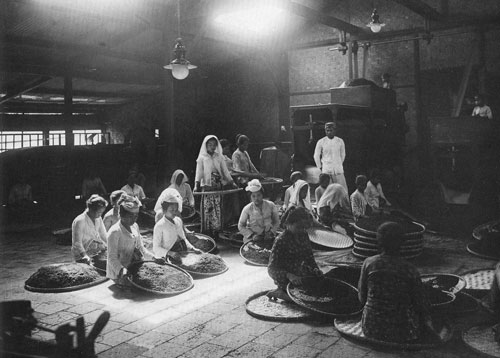 |
| #162: After the drying process the tea is sorted by sorters. The photo shows the interior of the Tjikadjang enterprise near Garoet. |
| |
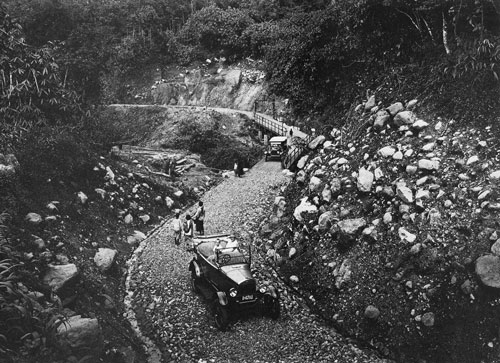 |
| #163: Plantation road of Boenisari. In the old Ford Mrs Ament and her son Eduard are sitting, who was named after his grandfather of East Tandjong. |
| |
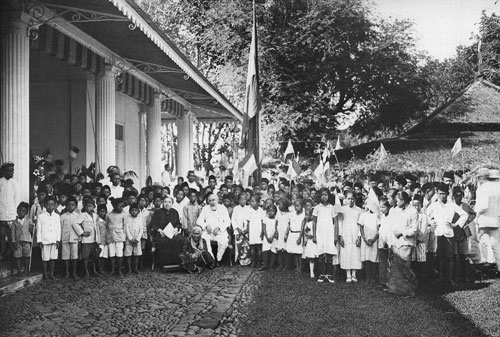 |
#164: Eduard Ament, landowner of East Tandjong and Tjiboeboer – between Batavia and Buitenzorg – at his golden jubilee in 1928, that was celebrated very festively.
His grandfather, Tjalling Ament, originating from Dokkum, made his career in the Indies as an official and is the forefather of this family in the Indies. Through his marriage to Dina Cornelia van Riemsdijk, a great granddaughter of Jeremias van Riemsdijk, who became governor-general of the Indies at the end of 1775, he gained the land East Tandjong in 1860 on hereditary lease. On his death, the land became the property of his son and further descendants.
Thilly Weissenborn compiled an extensive report of the festivities in 1928. |
| |
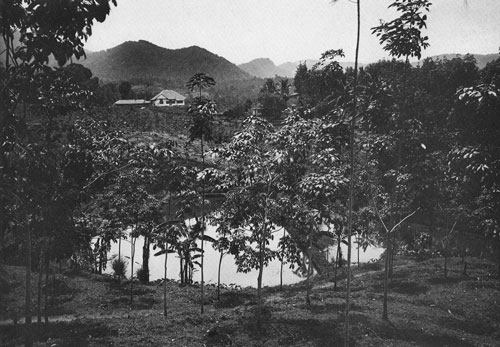 |
| #165: Very young rubber plantings in Boenisari. An employee’s house. |
| |
 |
#166: The Boenisari rubber factory.
After tapping the latex it is collected in buckets and transported to the factory. There the latex is mixed there until a mixture with a certain percentage of dry rubber is obtained. The mixture goes into coagulation tanks, formic acid is added, and directly afterwards aluminium plates are placed in the tank. Coagulation then takes place.
Following this is the rolling of the plates. The last rolling brings about a “print”. The slabs, the sheets, go to the smokehouses, lose their moisture after a week and gain a brown transparent colour. (According to advice by Mr Bovenkerk, from the St Michiel system).
In the photo rubber sheets are wrapped with jute and made ready to send after being squashed together in the press. |
| |
 |
| #167: Rubber planting with young trees. |
| |
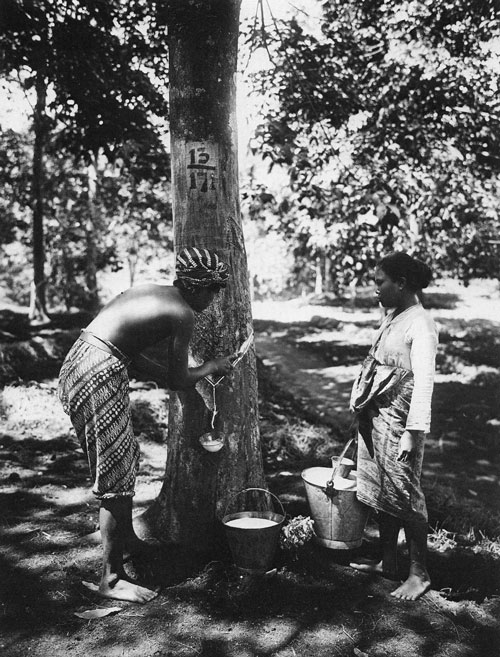 |
| #168: The tapping of rubber (latex) by slicing the bark. Here a slice is made in a V-form, an old tapping method. |
| |
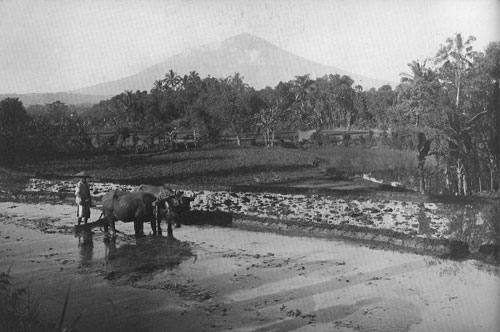 |
| #169: The tani ploughs his sawahs with his buffaloes. On the hill on the left lies Ngamplang. In the distance Tjikoeraj can be seen. |
| |
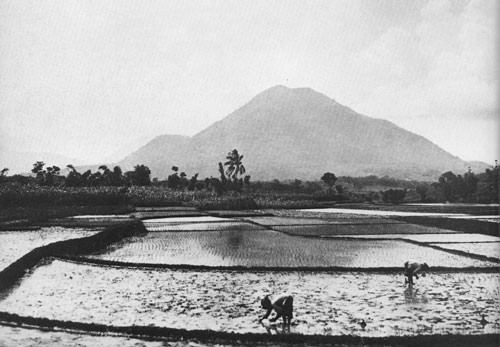 |
| #170: The planting of the bibit (= young rice plants) on the plain of Lèlès. |
| |
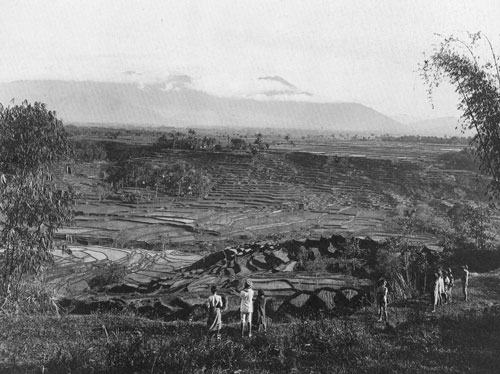 |
| #171: “Java’s pomp and splendour” – this image looks like it could have been the model for the book of this title that the English writer H. Ponder wrote in 1934. |
| |
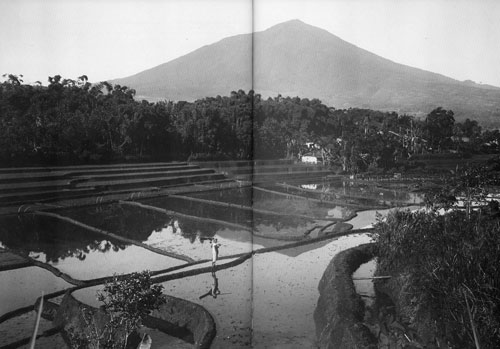 |
| #172: View of a sawah from Ngamplang. |
| |
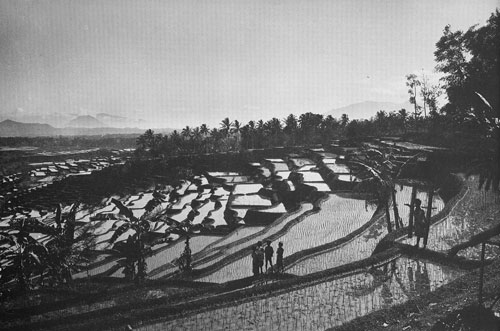 |
| #173: Terrace-formed wet rice paddies with young rice plants. The little dikes (galangan) serve to retain the irrigation water. On the right in the photo a boy who is carrying palm wine in bamboo tubes. |
| |
 |
| #174: Bibit (young rice plants), just planted in the wet rice paddies. |
| |
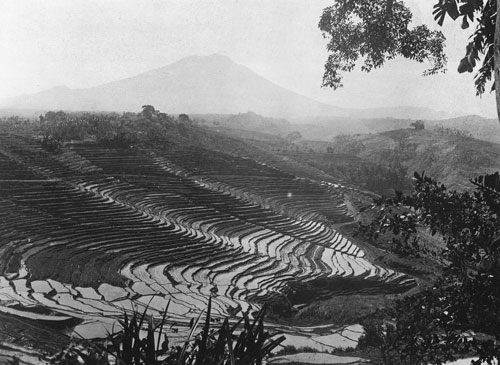 |
| #175: Sawahs in Bali with a view of Mount Batoer. |
| |
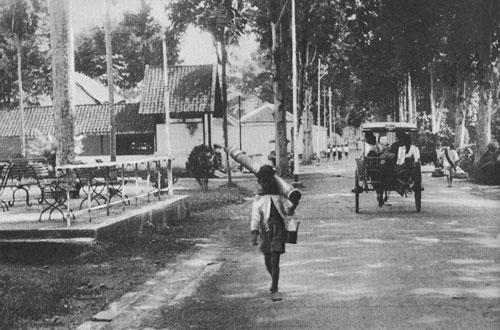 |
#176: Society Street in Garoet in the direction of the aloen-aloen. To the left is the terrace of the club. To the right a “deleman” with passengers and driver.
The boy in the foreground is carrying a lodong (bamboo pipe) with lahang or toewak (palm wine), the sap of the sugar palm. This type of palm is called arèn and in the Soenda-country kawoeng. The tapping of the lahang is called njadap.
The lodong is hung under the opening of the kawoeng flower stalk to catch the dripping fluid. After a cooking process and steaming the brown goela arèn is made from lahang. |
| |
 |
| #177: A Chinese toko near Boenisari. |
| |
 |
| #178: The fertilisation of vanilla. |
| |
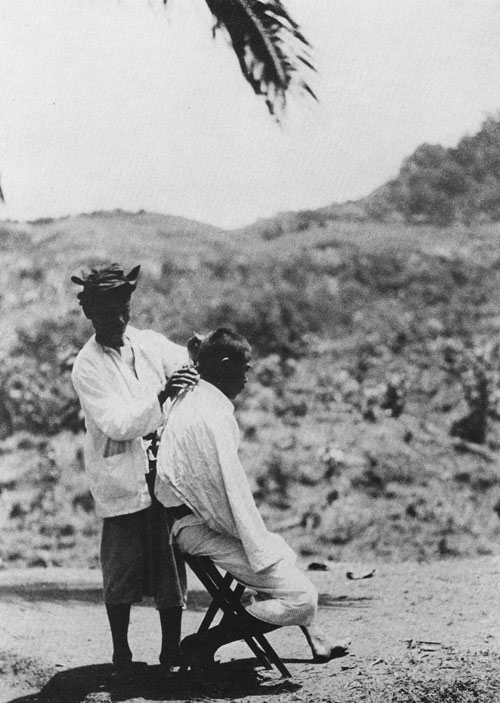 |
| #179: The toekang tjoekoer has his hair salon in the open air. |
| |
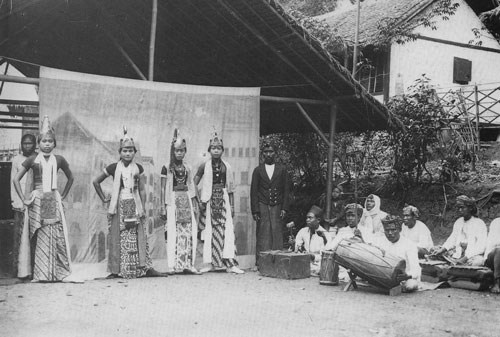 |
| #180: Wajang-orang performers with gamelan orchestra. |
| |
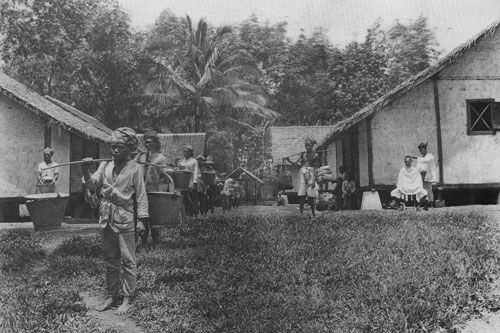 |
| #181: Housing in a village. The carriers are transporting latex, the barber is doing his work. |
| |
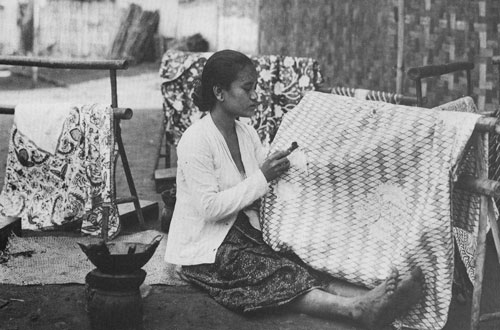 |
| #182: Soendanese batik workers |
| |
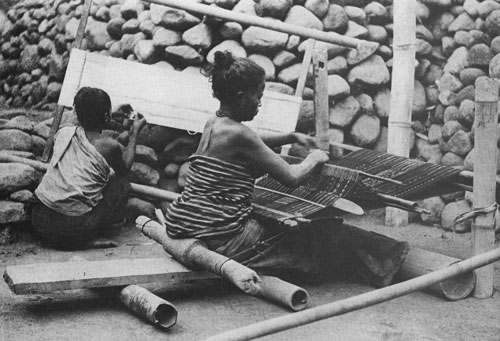 |
| #183: A weaver in Preanger |
| |
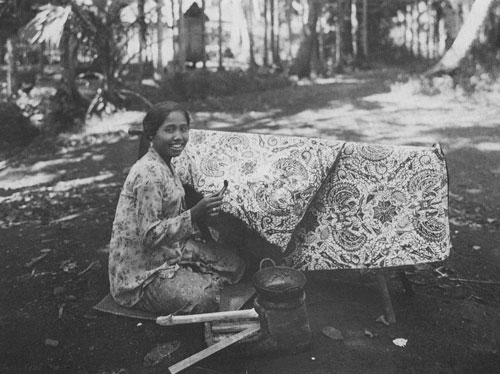 |
| #184: Soendanese batik workers |
| |
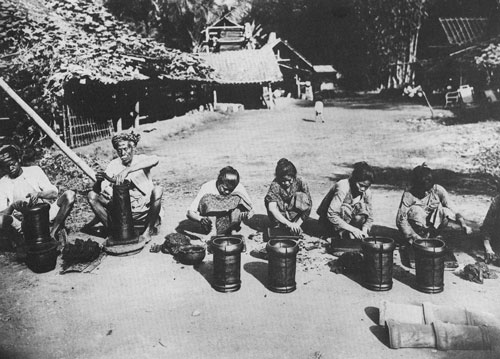 |
| #185: The potter’s workshop of Tjiboejoetan near Lake Bagendit. |
| |
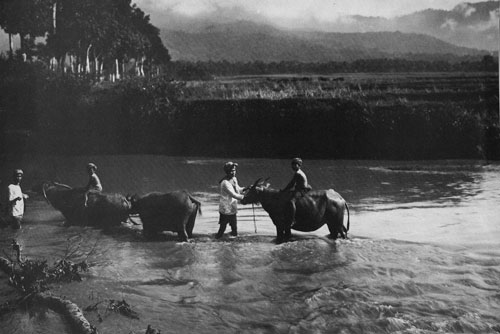 |
| #186: Buffaloes – these tame buffaloes are called moending – wade through the Tjimanoek with their keepers. |
| |
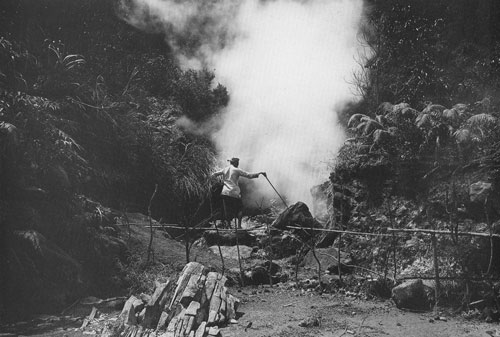 |
| #187: A volcano watcher near a natural gas spring of the Kawah Kamodjan |
| |
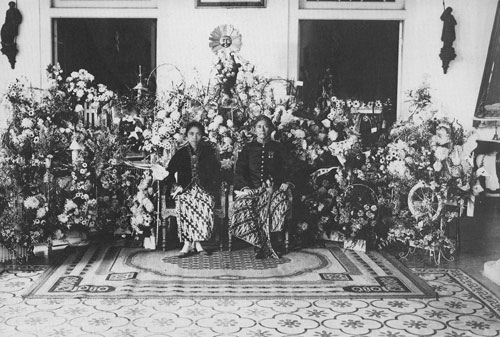 |
| #188: Raden Adiparti Aria Martanagara, Regent of Bandoeng with Raden Ajoe his wife at his 25-year official jubilee in July 1918. |
| |
 |
#189: April 1922. The unveiling of the monument for the Regent of Soemedang, who died a year previously, by Governor-General Fock on the aloen-aloen.
Aria Soeria Atmadja – he had the highest title that a regent can have: Pangeran, and furthermore Sampoerna, which means “perfect” – died in June 1921 at the same time as his wife and two servants in Mecca.
This offspring of the royal house that had governed Soemedang for a memorable period, was regarded highly by everyone because of his qualities as a person and as administrator of his territory. He was regent for 36 years, until 1919 and lived to the age of 70. |
| |
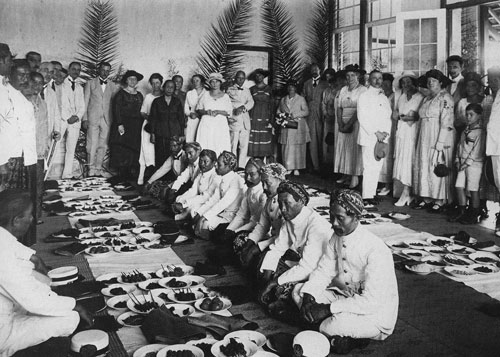 |
| #190: The ceremonial festive meal at the inauguration of the Garoet Provincial Hospital in March 1922, at which senior and junior Dutch and indigenous administrative officers were present. Sister Hulshoff stands to the left of centre next to the lady with the dark hat. |
| |
 |
| #191: Soendanese bridal couple |
| |
The photos for this book were made available by:
E Ament, doctor, Bergum
Mrs J Bernelot Moens-Hacks, Epe
Mrs L Biese-Wehrli ( April 1982), Luzern
K Brulez, The Hague
F Dam, The Hague
Ernst Drissen, Hertogenbosch
H Hacks, Amstelveen
H Holthuis, Soest
Mrs D Hundling-Andrée Wiltens, Naarden
Mr J Kerbosch, Tilburg
Mrs G Knottenbelt-Raffloer, Haarlem
Mrs R Koch-Halewijn, Bussum
T Kraemer, Baarn
Dr W Kruyt, Haarlem
Th. van Leeuwen, The Hague
Mrs D Ligthart-Feuilletau de Bruyn, The Hague
Prof Dr JMulder, Oegstgeest
Mr and Mrs Van Nistelrooy-Wijnmalen, The Hague
J Postema, Delden
Mrs I Rombouts, Baarn
Mrs I Tio-Andrée Wiltens, Amstelveen
Mrs E Withaar-Hartog, Zeist
B Wolff, Dordrecht
The following photos are sourced from the Royal Institute for the Tropics in Amsterdam: page 37 below, 48, 52 below, 53, 81 above, 127 and 128.
The photos on pages 31, 61 and 104 (below) are prints from still existing small format negatives.
Unless otherwise indicated, the photos were taken in West Java. |
| |
| |
Thilly Weissenborn was, as far as is known, the first female photographer in the former Netherlands Indies. She was born in 1889 in Kediri in East Java. After having worked for several years with the famous photographer Kurkdjian, she became the owner of the photo studio Lux in Garoet in 1920. Thilly Weissenborn’s photos excel in their extraordinary clarity and their perfect composition. The almost translucent faces, pictures of rice paddies, volcanoes and grandiose landscapes reflect the essence of the country that continues to fascinate thousands of visitors. She also knew how to achieve a perfect atmosphere in her portraits, interior shots and of people in their daily life in the pre-war Indies. |
| |
-------------------------
Return to text for the book
Return to Weissenborn main page |
| |